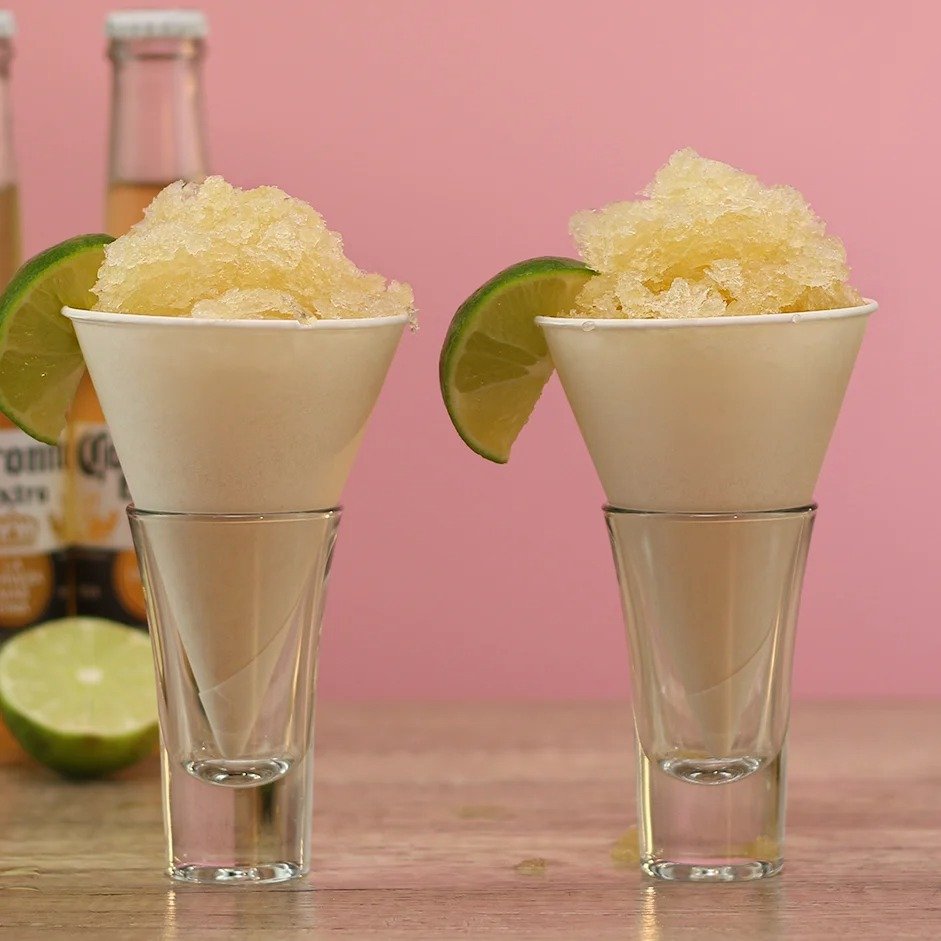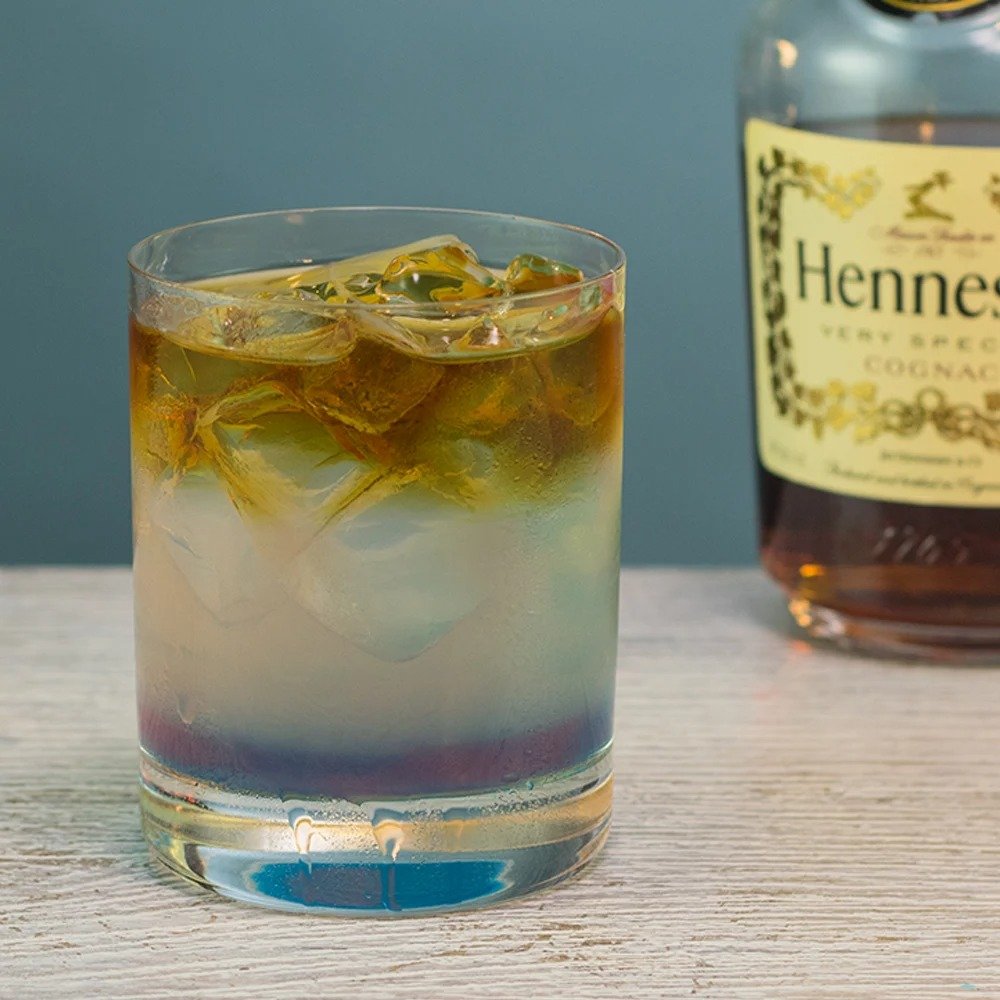
The Ultimate Tequila Guide: Everything You Need to Know!
WELCOME TO TEQUILA
We're going to go ahead and guess that you've had some pretty insane tequila nights in your drinking career, which either still make you smile years later, or give you some horrendous PTSD (Post Tequila Shots Disorder). Either way, the agave-based liquor stands out among all the other booze types as an especially party-friendly liquid shortcut to making some very entertaining — and yeah, questionable — decisions. But how much do you really know about tequila? Have you ever taken a few minutes to sit down, and really get to know the booze that's responsible for all those things you can never tell your mom? https://giphy.com/embed/wjK3YnjoQf0go Well folks, here's your chance to get nice and intimate with tequila. In the following Ultimate Tequila 101, we go over absolutely everything you need to know about tequila. We'll cover the history of tequila, how tequila is made, the different types of tequilas (including blanco, joven, reposado, añejo, and extra añejo), how tequila is regulated via the Normas Oficiales Mexicanas (NOM), and how to drink tequila like a true vaquero. By the time you're through with this tequila guide, you won't only know just about everything you'll ever need to about tequila, you'll be well on your way to becoming a jimador — also, you'll learn what a jimador is. So let's get to it! https://giphy.com/embed/Zq7zJ3dhazQgEWHAT IS TEQUILA?
Tequila is a liquor made from blue agave (alternatively Agave tequilana, agave azul, or the Agave Weber) plants — which are more closely related to lilies than cacti! — located in the state of Jalisco and a few of its neighboring regions in Mexico. Tequila is technically a Mezcal (which is distilled alcohol made from all agave plants, not just the blue agave), and as of 1978, thanks to an official declaration by the Mexican government, if it's made anywhere else in the world, it ain't genuine tequila. In terms of turning the blue agave plant into tequila, that's a matter of taking the plant's sugars and adding yeast so that the yeast eats up the sugar and turns it into ethanol, which is what makes you do all those tequila-y things that you have pictures of on your phone, but they're in the deleted bin so they won't come up if you show somebody a picture of your cat. https://giphy.com/embed/IMlIBJfiJ0qZ2 But overall tequila, unlike brain-punchingly complicated whiskey, is pretty simple. Plant the blue agave plants, harvest them, cut them up, bake them, soak them in warm water to extract their sugars, take the sugar-saturated water, let yeast munch on it to make ethanol and a few other byproducts, then distill the ethanol and, in some but not all instances, barrel age it. There are obviously a lot more details to cover, including the differences between tequilas made in the lowlands and the highlands, 100% blue agave tequila vs. mixto tequila, and what makes all the different types of tequila distinctive. But chill, people, 'cause we're going to cover all that: This isn't a shot of information you do with lime and salt, you gotta sip all this tequila 101 in nice and slow. (Although we're, of course, always down for shots.) https://giphy.com/embed/xT4ApaJ7fV3VWQtyeYA BRIEF TEQUILA HISTORY
Now that we have an understanding of what tequila is, let's take a quick look at the history of tequila, and how it bloomed from a creamy low ABV beer that ancient peoples thought of as a goddess's blood into what we now use for naughty body shots. Obviously this little bit of history only scratches the surface of the tequila story, but it's enough information so that you can impress somebody at the bar.FIRST UP: THE MYTH OF HOW AGAVE-DERIVED BOOZE WAS MADE ('CAUSE IT'S EPIC):
The myth of how tequila was made, which was generated by the Aztecs, is outline below (shout out to The Spruce for succinctly telling the tale): When Earth was made, an evil goddess named Tzintzimitl was in the sky and she was doing all kinds of crazy sh*t like devouring light and spreading darkness, and people had to make sacrifices to regain some of the lost light. https://giphy.com/embed/7VBoVupl8EAHC At some point, Quetzalcoatl, the "Feathered Serpent" deity, was like: "enough of that noise, woman," and he popped up into the sky to fight the goddess. But instead he found Tzintzimitl's granddaughter, Mayahuel, the goddess of fertility who had 400 boobies. Quetzalcoatl was understandably sidetracked by Mayahuel and he was like, forget Tzintzimitl, I'm on this fertility goddess game now. They went back to earth to live together, but Tzintzimitl chased them around, so they were forced to run and hide from her. But after an excess of running and hiding, they decided to just chill and turn themselves into trees. https://giphy.com/embed/10V3FNM7bxPWy4 Tzintzimitl did eventually find them though, and once she did, she killed Mayahuel. After burying Mayahuel, Quetzalcoatl was pissed, so he went up into the sky and slayed Tzintzimitl, which caused all the light to return to earth. https://giphy.com/embed/WzLDljBpplUvm But because Quetzalcoatl was still crazy sad, crying every night at Mayahuel's grave, the other gods decided to do something for him: On Mayahuel's gravesite, a plant began to grow. A plant with special hallucinogenic properties that would help to ease Quetzalcoatl's pain whenever he needed a little peace. That plant was, of course, the agave plant. And now we regular mortal people use that peace juice made from the agave plant for peace too. Or you know, crazy partying. https://giphy.com/embed/FVIflnMFdGoMw1,000-300 BCE: PULQUE MADE FOR THE FIRST TIME
Tequila has its roots in a drink known as pulque (sometimes referred to "agave wine"), which is thought to have been originally made more than 2,000 years ago. Basically pulque is the most basic, lowest ABV alcoholic beverage you can make from an agave plant, but even at 4-8% ABV, it was considered to be pretty dang magical by ancient peoples.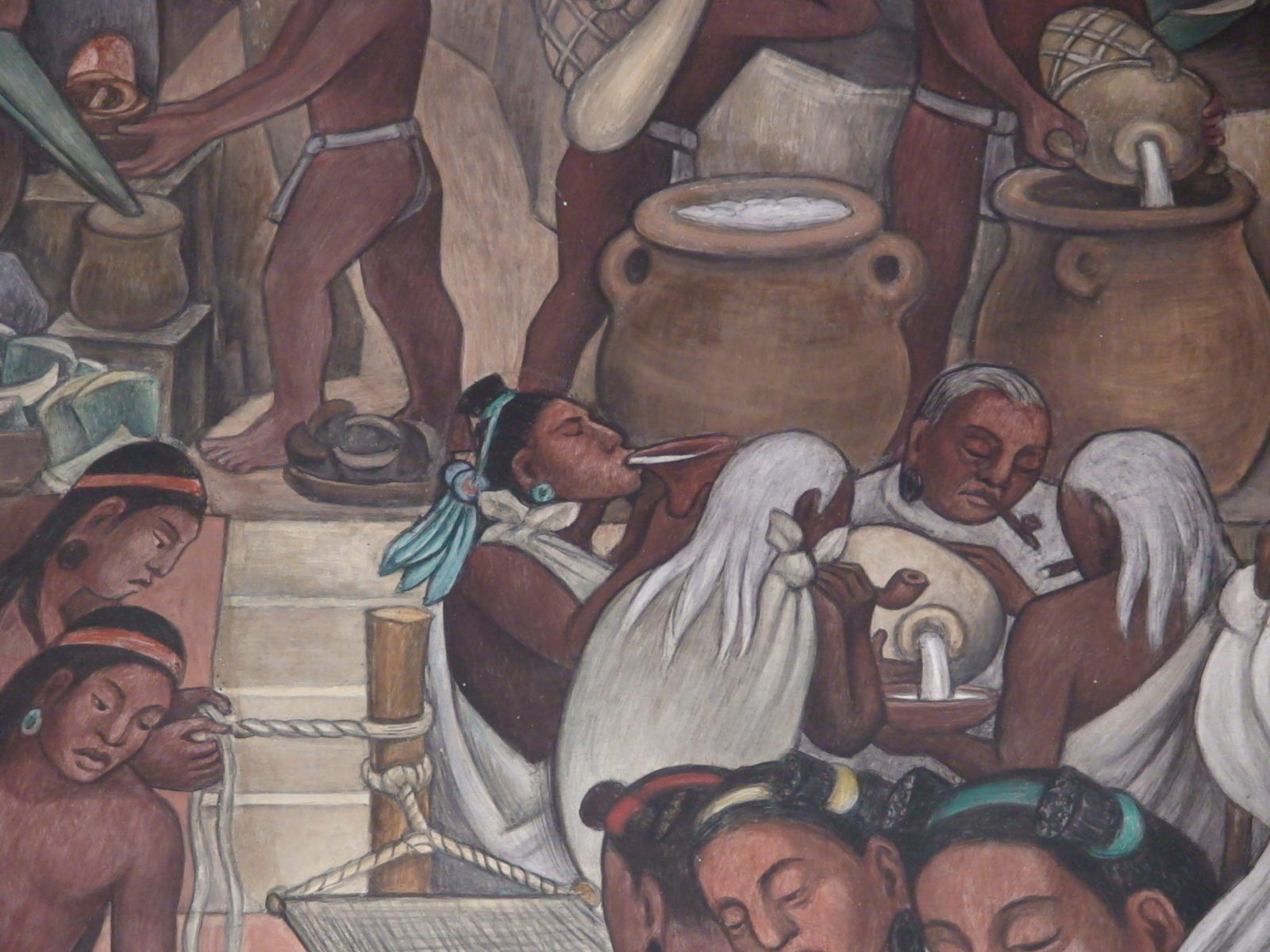
South American peoples drinking pulque. Image: Flickr / Rory Finneren
16TH CENTURY AD: MEZCAL MADE FOR THE FIRST TIME
Although pulque was made continuously throughout the centuries between the time of the Olmec civilization and the Aztec civilization — which arose around the 14th century — it wasn't until the 16th century that the agave plant was not only fermented, but also distilled; an evolution catalyzed by invading Spanish conquistadors, probably around 1521. As the (hotly debated) story goes, the conquistadors loved getting tipsy on their own brandy brought over from Spain, but once they ran out of it, they looked to distilling pulque beer into a higher ABV beverage. That new, distilled beverage was dubbed mezcal, which comes from the Nahuatl word mexcalli, and literally translates to "oven-cooked agave."
A bottle of unflavored pulque beer. Image: Wikimedia / AlejandroLinaresGarcia
A key point to note with this first distillation of agave-derived alcohol however — why it was really only mezcal and not tequila created at this point — is how exactly the agave piñas were "oven cooked." (Piña being the name for the heart of the agave plant after its leaves have been sheered off, because it looks like a pineapple.) In the 16th century, and up until today, in fact, mezcals (at least most of them, there are exceptions) were and are cooked using underground, earthen pits.
Conquistadors with natives. Image: Wikimedia / Pedro Lira
Piñas used for tequila, on the other hand, are cooked using alternative methods, with autoclaves, hornos, etc. So even though agave plants were being harvested, baked, fermented, and distilled during this period, tequila was not technically being made due to the fact that the piñas were being baked in earthen pits rather than industrial ovens. Also, the distilled agave liquor being made by conquistadors as this point were probably (read: definitely) not all made from the blue agave.18TH CENTURY: TEQUILA AS WE KNOW IT EMERGES AS A DISTINCT SPIRIT
As far as when exactly tequila emerged as a distinct spirit, this is where things get real tricky. The problem, it seems, is that most online sources have trouble deciding when tequila emerged as its own type of distilled spirit as it's not only technically a mezcal, but also because what separates it from other mezcals that aren't tequila is ultimately — going to speak some blasphemy right here — somewhat trivial. https://giphy.com/embed/10tuFEeuACAnuw Because of this blurry line between mezcal and tequila, it's hard to say exactly when tequila — made solely from the blue agave plant, oven cooked in proper above-ground ovens, and made in the state of Jalisco and some surrounding municipalities — became a thing. For example, Wikipedia says that "Tequila was first produced in the 16th century near the location of the city of Tequila, which was not officially established until 1666." But the source it references for this claim itself notes that "Tequila's history should be dated from the late 19th century when [above-ground, steam-heated] ovens came into use." So it seems that different sources are going to give you different origin dates for tequila. As for this guide, we'll go with tequila being established by the Cuervo family in the second half of the 18th century, as there seems to be a decent consensus that this was at least the first time that genuine tequila was being mass produced.
Portrait of Don Jose Antonio de Cuervo. Image: Jose Cuervo
With that in mind, we're looking at 1795 as the year of the birth of tequila, as that's when Don Jose Antonio de Cuervo (a colonist from Spain) and his family produced the first Vino Mezcal de Tequila de Jose Cuervo, a.k.a. tequila. It was also around this time that Don Cuervo's son, Jose María Guadalupe de Cuervo, was granted a permit from King Carlos IV of Spain to make tequila commercially. And hey presto, the tequila industry was born.19TH & 20TH CENTURIES: TEQUILA COMES TO THE U.S., BECOMES AN OFFICIAL MEXICAN SPIRIT
After tequila became big business in Mexico, there were basically two more big milestones in its history that any armchair tequila expert should know about: when tequila started coming to the U.S., and when Mexico decided that it wasn't cool for anybody else on Earth to make it. In regards to exporting tequila to the U.S., Americans can enjoy this sweet spirit thanks to a man by the name of Don Cenobio Sauza. Sauza founded the Sauza at La Perseverancia distillery in 1873, and he was the first distiller to actually refer to the distilled spirit made from the blue agave plant as "tequila," and export the stuff to the U.S. (You're probably still familiar with Sauza, as it's one of the giant tequila producers — although it's owned by Beam Suntory.)
Don Cenobio Sauza Image: Casa Sauza
Throughout the early 20th centuries, tequila exports to the U.S. began to boom, at first because of Prohibition — American-made booze was obviously hard to come by, unless you had a prescription for whiskey or something like that — and then later on during WWII, when alcohol imports from European countries were greatly diminished. Then, in 1978, the Mexican government declared that the word "tequila" was the sole intellectual property of Mexico, making it illegal for any other countries to sell a product by the same name. So, by the second half of the 20th century, tequila had become a distinct spirit that could only be produced in Mexico. Fast forward to now, and you're looking at an industry that's expected to be worth about $9 billion by 2019. Which is a long way to come from ancient civilization god-blood juice, and also a helluva a lot of shots. https://giphy.com/embed/sMduEx4ghxYmQMEZCAL VS. TEQUILA ('CAUSE IT'S GOING TO COME UP)
When it comes to mezcal vs. tequila, what you'll hear over and over again is this: All tequilas are mezcals, but not all mezcals are tequilas. Which is technically true because mezcal is any "distilled alcoholic beverage made from any type of agave plant native to Mexico," and tequila is most definitely a distilled alcoholic beverage made from an agave plant in Mexico. So before we clarify the difference between the two, keep in mind that tequila is a type of mezcal. https://giphy.com/embed/3o6wrjHZkRiIXQFlgQ 1. Mezcal and tequila are produced in different states in Mexico. Tequila is mainly produced in Jalisco, while mezcal is mainly produced in Oaxaca. Keep in mind, however, that both spirits are also produced in (very limited) respective surrounding regions, and that some regions produce both tequila and mezcal. 2. Tequila, by law, can only be made with the blue agave plant. Mezcal on the other hand, can be made with more than 30 different types of agave plant, although the majority are made with Agave Espadin. 3. Although both Tequila and mezcal are produced from agave plants, their differing production methods cause changes in flavor. For example, it's common for mezcals to have a smoky flavor due to their unique roasting process. Some also note that Mezcals tend to taste sweeter and richer than tequila. So if you're at the bar and you want to pop off with a display of overarching agave-spirit knowledge, those are basically the points you need to know. https://giphy.com/embed/coYo4nM8jE1TWHOW TEQUILA IS MADE
Now that we know what tequila is, and how it differs from mezcal, let's take a look at how this Mexican spirit is actually made. Below are the seven basic steps involved, from planting the blue agave to bottling the tequila.1. HARVESTING BLUE AGAVE
Blue agave plants are ready to become tequila somewhere between eight to 12 years after they've been planted, and are harvested when their sugar content is somewhere above 24% — a minimum percentage mandated by law. The plants are harvested by jimadors, who are a special type of Mexican farmer who's been trained to identify perfectly ripe agave. (See, told you you'd learn what jimadors are.)
A jimador chopping the leaves from a piña. Image: Flickr / omarsan
The jimadors use coa de jima, or "hoes for harvesting," to cut away the agave plants' leaves, leaving the heart of the agave plant, the piña, which is then stuck in a truck and sent to be cooked. https://giphy.com/embed/2shPJo68inkbu2. COOKING THE PIÑAS
Now that the piñas have been plucked and had their leaves sheared off, it's time to do some cookin'! This step occurs in order to catalyze the chemical process within the piña that converts complex carbohydrates into fermentable sugars. Cooking also softens the piñas, which allows said fermentable sugars to be extracted more easily. That's the explanation of what's happening with this step into terms of the why. In regards to the how, you have the three following options for cooking the piñas, although keep in mind that the word "cooking" is used very loosely here. HORNO (OVEN) First up, we have the horno or oven, which is usually made out of clay, stone, or ceramic, although there are other types as well. Although this method uses an "oven" and refers to the agave cooked this way as being "oven cooked," what's actually happening here is a pressurized steaming of the agave.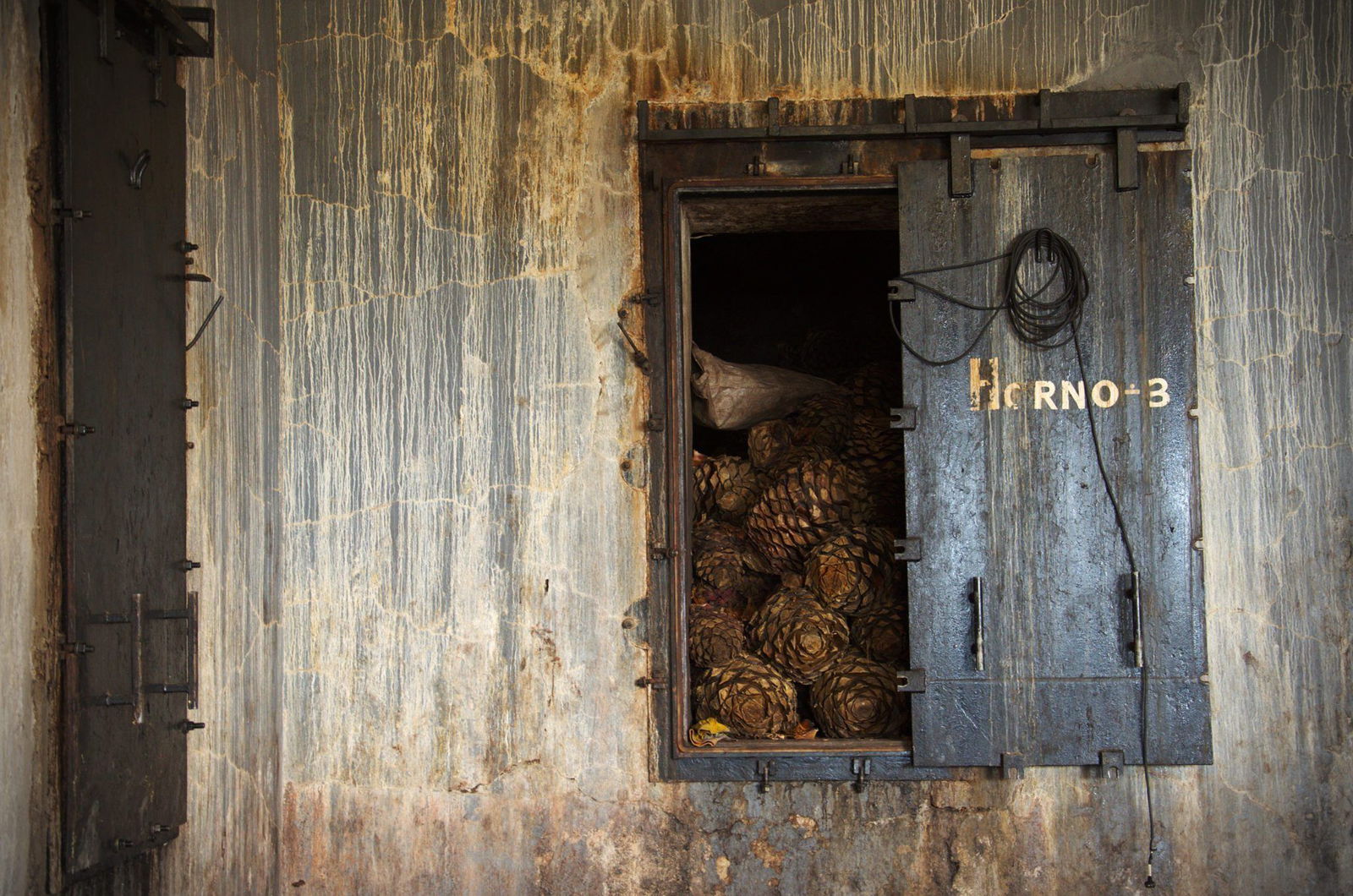
A look at one type of horno. Image: Flickr / Gabriel Saldana
Hornos tend to add tones of fruitiness and cooked agave to the final tequila product, as well as an increase in the toasted sugar and caramel flavoring to the drink's finish. AUTOCLAVE A second option for cooking the piñas utilizes what's known as an autoclave. Autoclaves are made of steel, and are more modern and more efficient (i.e. faster) than hornos. Autoclaves, like hornos, use high-pressure steam to cook the agave piñas, but while hornos can take up to anywhere from 22 to 56 hours to get the job done, autoclaves only need about eight. (Although sometimes agave are left in autoclaves for a full 24-hour day.) On top of cooking faster, autoclaves don't impart any flavor characteristics to the agave like the hornos do. Because of this, it is often thought that autoclaves create cleaner, yet less complex tequila end products.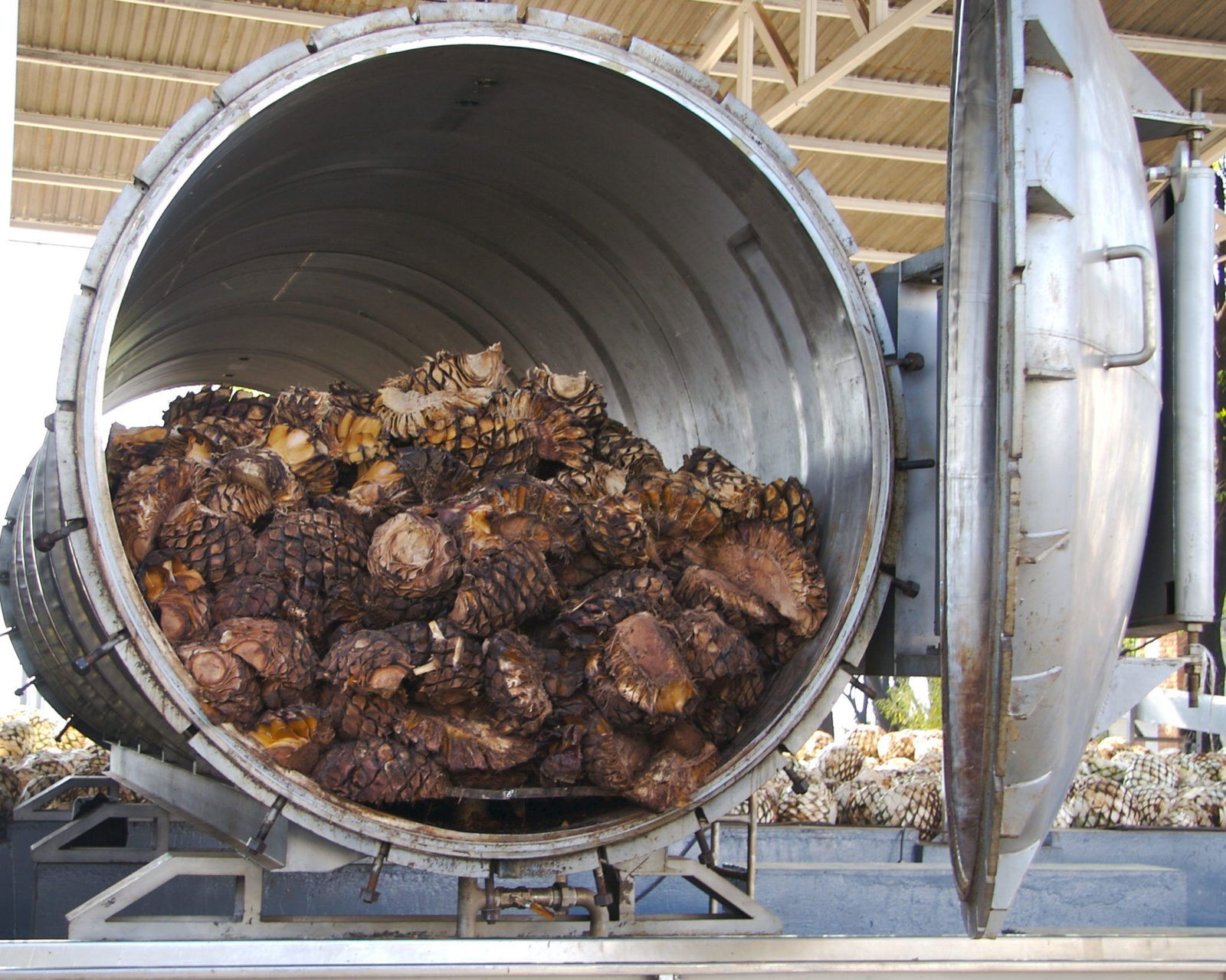
Picture of a tequila diffuser. Image: Flickr / Bill Bumgarner
DIFFUSER Finally, we have the diffuser, which is considered by the tequila-drinking community to be a somewhat heretical tool for cooking agave piñas. The diffuser, which looks like a massive hunk of generic industrial machinery (pictured below), inverses the processes executed with the other two methods, by first extracting the starches that will be turned into fermentable sugars from the piñas by blasting the agave with high-pressure water as they pass by on a conveyor belt and then cooking them. As the slurry of agave pulp comes out of the diffuser, it's poured into vertical autoclaves that cook everything, which causes the starches to be converted into fermentable sugars. Sometimes, however, the agave aren't even cooked after they've been water-blasted, but are instead bathed in hydrochloric acid, which is used in place of heat to convert the starches into fermentable sugars.Why do tequila producers bother with diffusers for cooking agave if it's generally despised — which is not hyperbole in this context, trust — and there are other methods available? We bet you can guess: It's cheaper and faster than the other methods. Which means the biggest tequila producers out there, including Jose Cuervo and Sauza, use this method for many of their tequila lines.The Diffusor in Tequila Production: Are They Cheating? - Tequila Aficionado https://t.co/41jG3P1aHR pic.twitter.com/Aj0GHm7D3d
— Tequila Aficionado Media (@TequilaAficion) December 29, 2015
3. SHREDDING THE PIÑAS
Once the piñas have been cooked, they're taken to a milling area where they're crushed in order to have their sugary juices, or aguamiel, extracted. This process is executed by sticking the piñas in a pit and then crushing them with a tahona, which is basically a large stone wheel that's tied to a wooden stake, and rolled around in circles over and over thanks to mule power — seriously, this is some Flinstones kind of shit. Then, after the piñas are crushed, they're soaked in water in order to extract the sugars. The mashed piñas are strained out of the sugary juice, and often reused as compost or for animal feed. (Sometimes it's even burned as fuel or processed into paper.)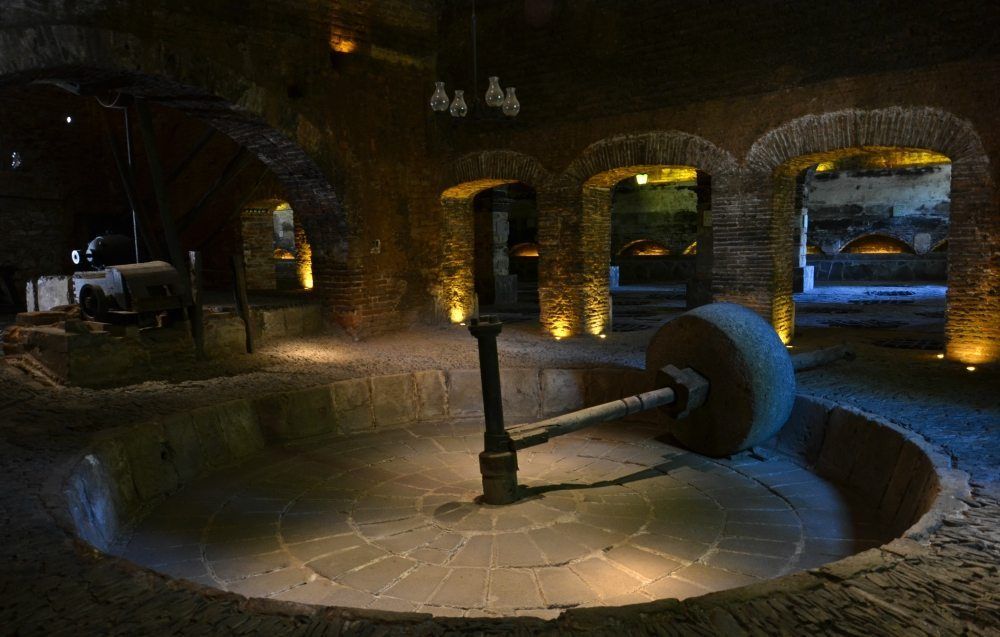
Tahona used for crushing piñas. Image: Flickr / omarsan
Again, as with diffusers, many modern tequila producers have forfeited the ol' stone wheel and donkey in favor of a mechanical crusher that separates the piña fibers from the aguamiel. Although this substitution is a little more understandable than the diffusers, as it's the 21st century and mule power isn't really a thing anymore.4. FERMENTING THE JUICE
Once the aguamiel has been extracted from the cooked, crushed piñas (we only destroy you because we love you, piñas), it's then time to start fermenting some sugar water in order to create some booze! This happens by taking the aguamiel and dumping it into large tanks made out of either wood or stainless steel. The aguamiel is usually fermented with yeast — recall that yeast is a type of single-celled fungus — that's taken from the agave plants themselves. Other types of yeast are sometimes added however, such as commercial brewers' yeast, in order to encourage a different end product.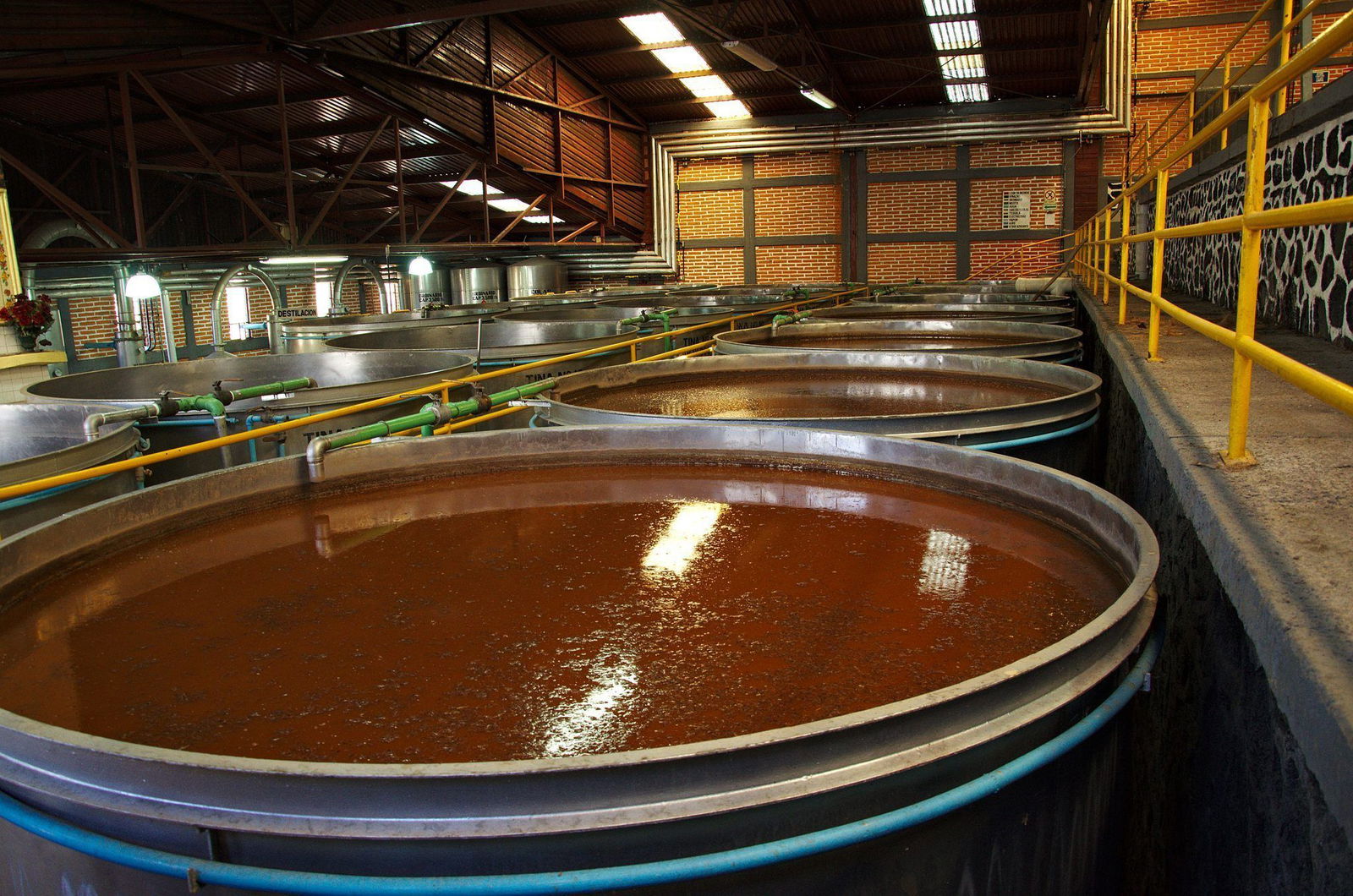
Tequila fermentation tanks. Image: Flickr / Gabriel Saldana
The below GIF gives a little glimpse at what tequila fermentation actually looks like. https://giphy.com/embed/39u4aWvuTHAtNdZ5ho5. DISTILLATION OF FERMENTED JUICE
Once you have the fermented aguamiel, it's time to distill it, because right after the fermentation step, it's only at about 4-5% ABV, and that needs to be upped to about 35-28% ABV in Mexico, and at least 40% ABV (by law) in the U.S.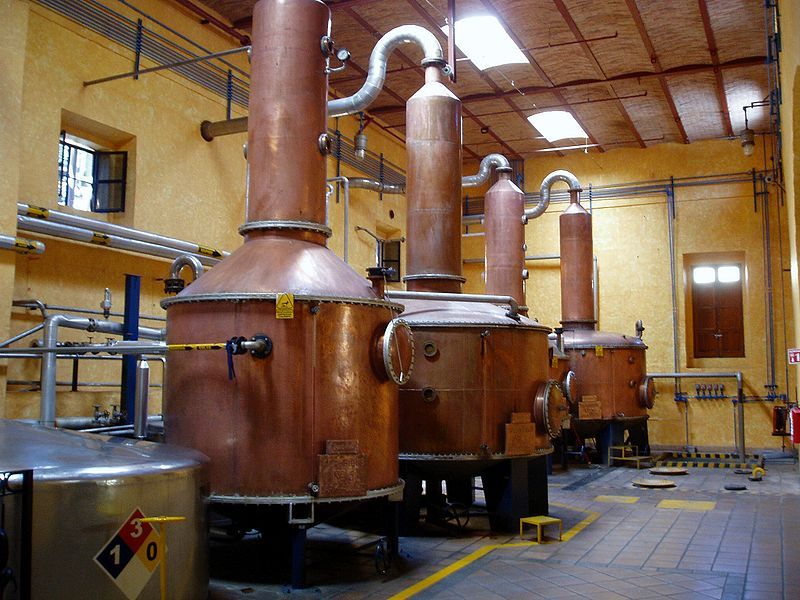
Jose Cuervo copper tequila stills. Image: Wikimedia / Creative Commons
So, in order to distill the aguamiel, it's taken and placed in a type of pot still used specifically for tequila distillation called an Alembic still or Alambique in Spanish. If you're unfamiliar with how the distillation process works, the general concept is super easy to grasp: Basically, a still — not just an Alambique, but any still — is a big kettle that's placed over a fire. The kettle has a bowl-ish bottom leading up to a narrow, tubular top, and the aguamiel (in the case of tequila) is poured into the still's bottom. Once you light the fire, the heat from the bottom of the still causes the aguamiel — which is made up of ethanol (C2H6O) and water (H20) — to boil, thusly turning into a vapor. But because ethanol has a lower boiling temperature than water, 173.1 degrees Fahrenheit versus 212 degrees Fahrenheit, you'll have a lot more ethanol vapor firing up the still than water. What does this mean? The liquid that comes out of the opening of the long tubular neck at the top is going to be much higher ABV than what you started with, because it has a lot less water in it.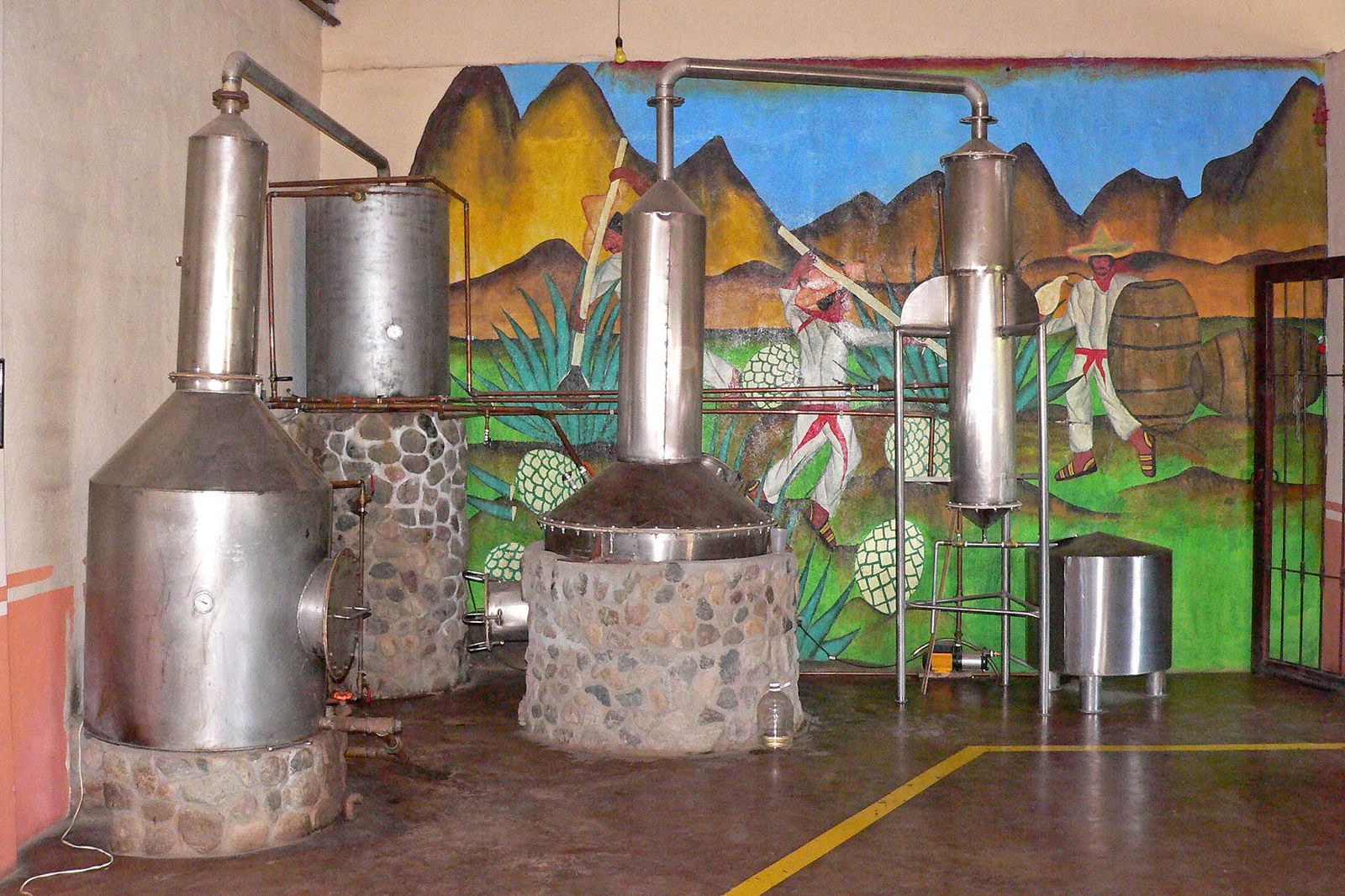
Steel tequila stills. Image: Wikimedia / Stan Shebs
Now, that's the basic distillation process in general. In terms of what goes on specifically with tequila distillation, you're looking at the aguamiel usually being distilled twice, the first time turning it into a 20% ABV liquid known as ordinario, and the second time turning it into a 55% ABV liquid known as rectification. In terms of how long each distillation takes, it's usually about two hours for the first distillation and three to four hours for the second distillation. After the second distillation is complete, you have silver, or blanco, tequila. In terms of tequila distillation caveats, an alambique still isn't always used, and tequila isn't always necessary only distilled twice — sometimes it's distilled three times, to up the ABV even further. A column still, or "Coffey Still" is sometimes used in place of the alambique, although, as Long Island Lou Tequila points out, column stills are usually used in conjunction with diffusers, which means they're often associated with poorer quality tequila.6. WATER ADDED/TEQUILA AGED (OPTIONAL STEPS)
Now that you have a distilled blue agave-based liquor, you have officially made tequila! But you've only made one type of tequila, silver or blanco (as mentioned earlier). If you want to make the other types of tequila, you'll need to add water, barrel age it, or both. As far as barrel aging is concerned, almost every barrel is a French or American white oak barrel that has previously been used to age Bourbon. Reposados are aged for anywhere from two to 12 months, Añejos for anywhere from one to three years, and extra añejos for over three years.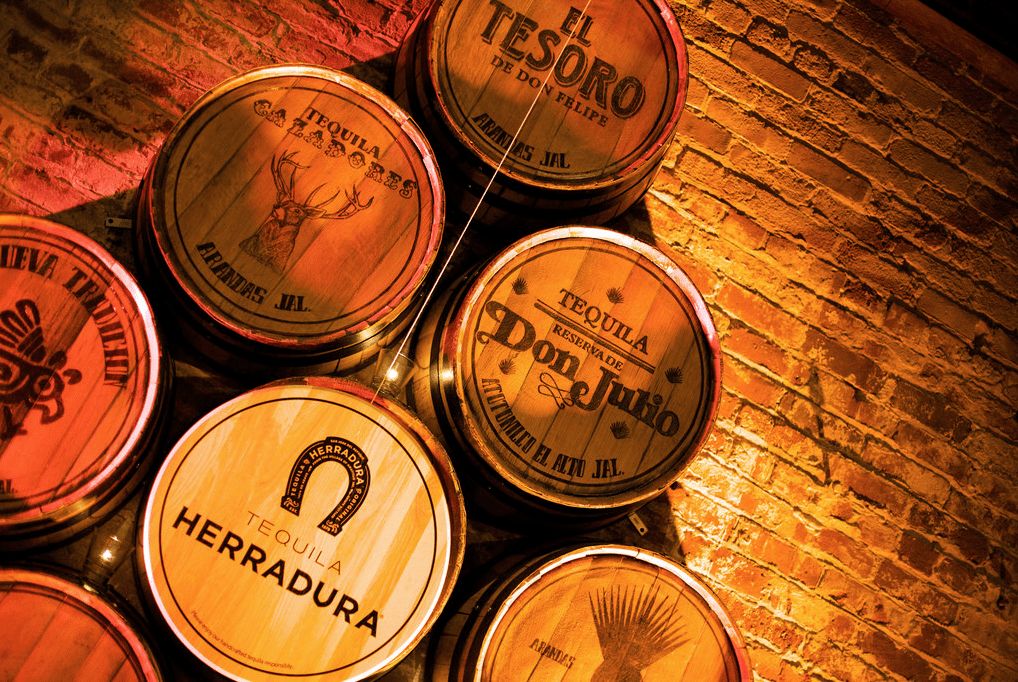
A sampling of tequila casks. Image: Flickr / Jeremy Brooks
Keep in mind that it is the barrel aging process that changes the color of tequila — when any type of tequila first comes out of the stills, it's clear, silver tequila. Most of the time, the longer a tequila ages, the more amber color it will take on, as well as barrel-derived flavor that comes from the absorption of tannins, which are chemical compounds that provide dry, sharp flavors similar to those of wine or black tea. Note that the condition of the barrels — how worn out they are and what they were previously used to age — will change the type of flavor profile the tequila takes on from the barrel in which it's aged.7. TEQUILA BOTTLING
Now that you have your blanco, joven, reposado, añejo, or extra añejo tequila, you're ready to bottle it! This process is more or less as straight forward as you'd imagine — take the dang tequila and stick it in bottles — but there are important naming procedures to note. https://giphy.com/embed/sRJdh37TS0RGqTejB5 Because Mexico is extremely tight with its tequila restrictions, bottles need to have an Appellation of Origin status printed on them, which, as defined by tequila.net, sets the "standards for certain [tequila] products that producers have to meet in order to make products called by certain names." So for a tequila to be labeled as such, "it must be produced in the declared territory... of Mexico, and the producer must follow the Official Standard for Tequila, known as NOM-006-SCFI-2005." That region being Jalisco or a handful of its surrounding municipalities. In terms of NOM standards, we'll get into that in a bit. On top of the Appellation of Origin, all 100% agave tequilas must have on their labels, Hecho en Mexico/Made in Mexico. Mixto tequilas, or tequilas that are not 100% blue agave, are allowed to be sold and bottled anywhere in the world (they only need to be made in Mexico).THE DIFFERENT CATEGORIES AND TYPES OF TEQUILA
Now that we know what tequila is and how it's made, let's take a deeper look at the different types of tequila.THE CATEGORIES OF TEQUILA
In terms of breaking down the different strains of tequila, you need to start with the two umbrella categories, which consist of 100% blue agave tequila, and Mixto tequila. As you probably guess by the names, this means that 100% blue agave is made with sugars only derived from the blue agave plant. Mixto tequilas, on the other hand, can be made with 51% sugars derived from the blue agave plant and the other 49% of its sugars derived from other plants besides the blue agave.100% BLUE AGAVE TEQUILA
Along with being produced from 100% blue agave-derived sugars, 100% blue agave tequila is also inspected and approved by a Mexican government inspector in order to confirm its purity. As you can imagine, out of the two umbrella tequila categories, 100% blue agave is considered to be far superior relative to mixto tequilas, especially by connoisseurs. However, even though 100% blue agave tequila is generally considered to be of much better quality, that moniker by itself doesn't guarantee the best quality. Different tequila distilleries have different processes, and some undergo a lot more quality control than others.
100% Pure Agave label on a bottle of DeLeon tequila. Image: Tipsy Bartender
MIXTO TEQUILA
Mixto tequila, as mentioned, can be made with up to 49% of alcohol derived from sugars other than those produced by the blue agave. And while 100% blue agave will always be labeled as such, keep in mind that mixto doesn't need to be labeled mixto — it can just be labeled tequila. That 49% of the mixto tequila's sugar not from 100% blue agave is usually derived from sugarcane, which delivers the same alcohol content as agave sugar, but a different flavor profile. Note that those 49% of sugars not derived from blue agave cannot be derived from other types of agave plants by Mexican law. Along with the allowance of up to 49% of sugars derived from other sources aside from blue agave, Mixto tequila can, unlike 100% blue agave, be bottled outside of Mexico. It may also contain caramel coloring, Natural oak or Encino oak extract, glycerin (another sweetener often used in prescription drugs), and a sugar-based syrup. And if you're thinking that all of these faux, sugary ingredients make a hangover more likely after drinking, you are most definitely right.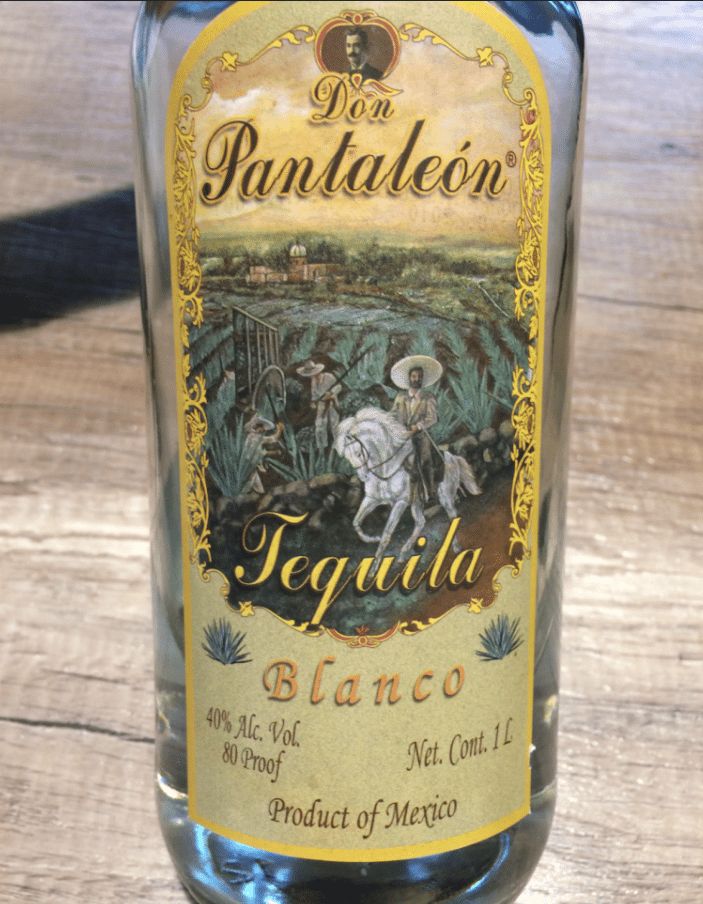
A mixto tequila — note that mixtos don't explicitly say that they are 100% agave. Image: Tipsy Bartender
THE TYPES OF TEQUILA
Now that we have the two categories of tequila down, let's get into the different types. It's important to note both category and type because they overlap. For example, you can have a mixto blanco, or a 100% blue agave blanco.PLATA OR BLANCO (SILVER)
As already mentioned, blanco tequila is tequila that comes straight from the stills — it's not aged at all, and therefore gains no distinctive flavors from any kind of barrel.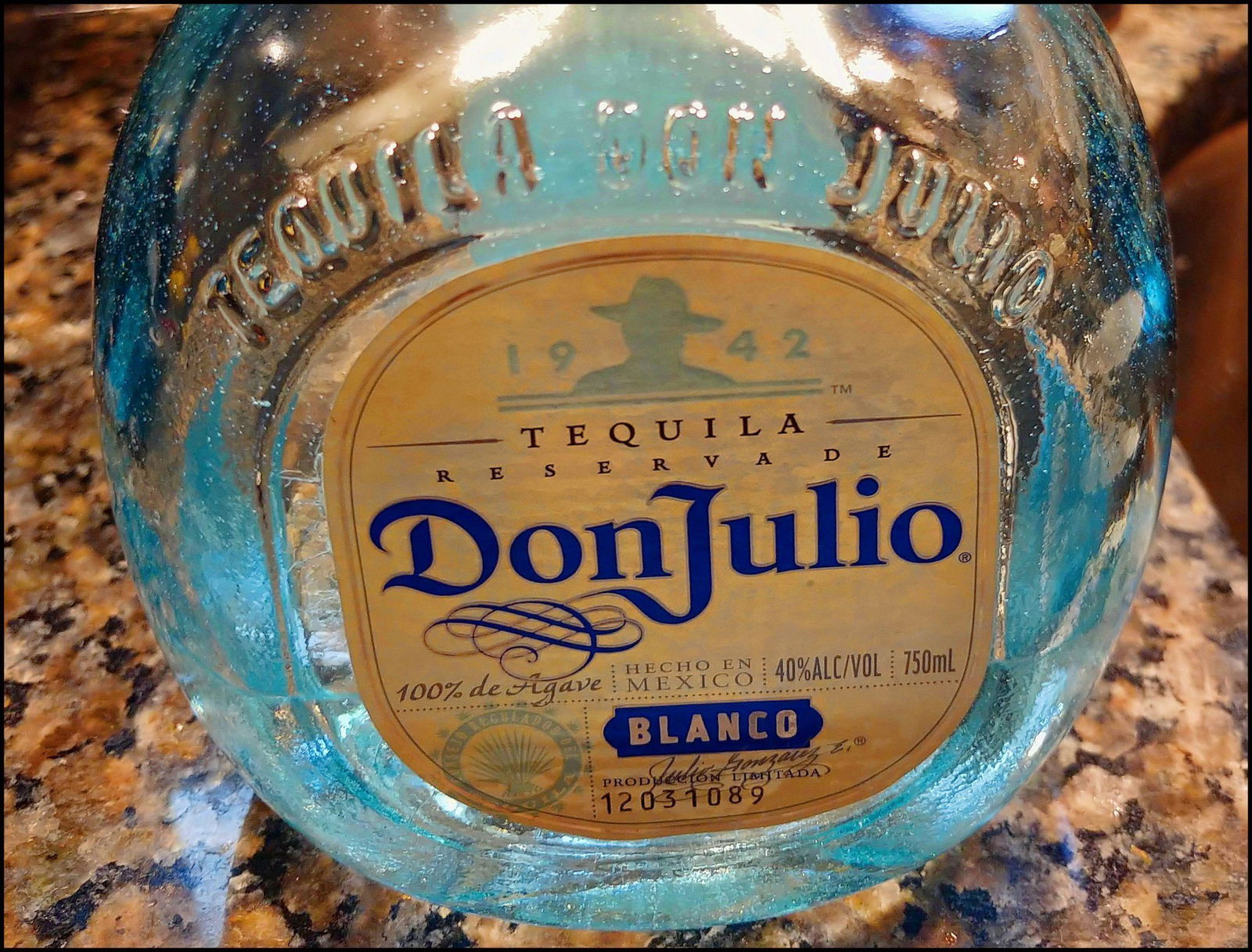
A blanco tequila bottle. Image: Wikimedia / Wesportwiki
JOVEN OR ORO (GOLD)
Joven tequila is, according to tequila.net, "typically a Mixto, where colorants and flavorings have been added prior to bottling." Joven tequila can also be a mix of blanco and a barrel-aged tequila. Due to the fact that Joven is relatively cheap and is usually a mixto (i.e. of inferior quality) it is often used by bartenders as the tequila base for mixed drinks such as a margarita or a Paloma.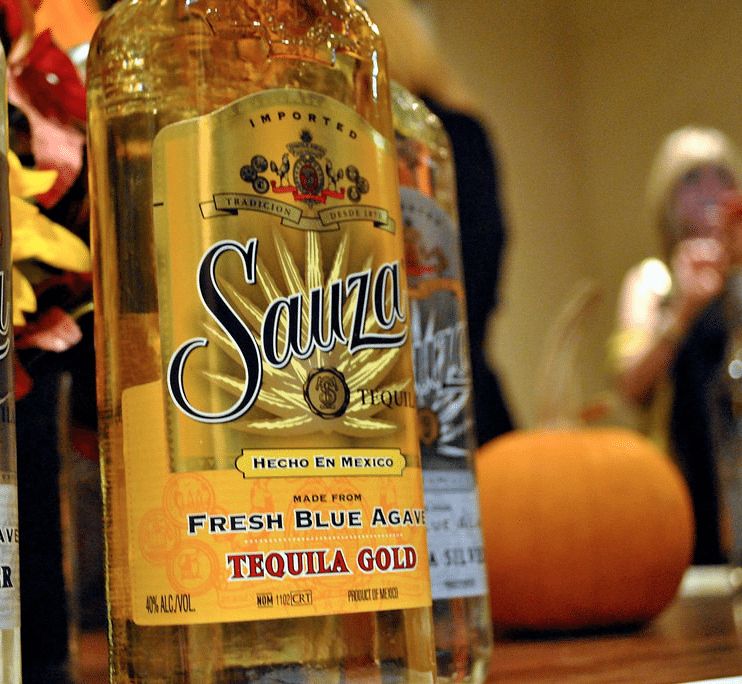
A bottle of Oro tequila. Image: Flickr / Nicole Yeary
REPOSADO (RESTED)
Reposado tequilas are aged for anywhere from two months to eleven months, which gives the tequila enough time to take on the golden hue and taste of the barrel in which it's being aged. Even this relatively short amount of barrel aging can also help to smooth out the flavor of the tequila, giving it less bite and a little bit more of a woody flavor.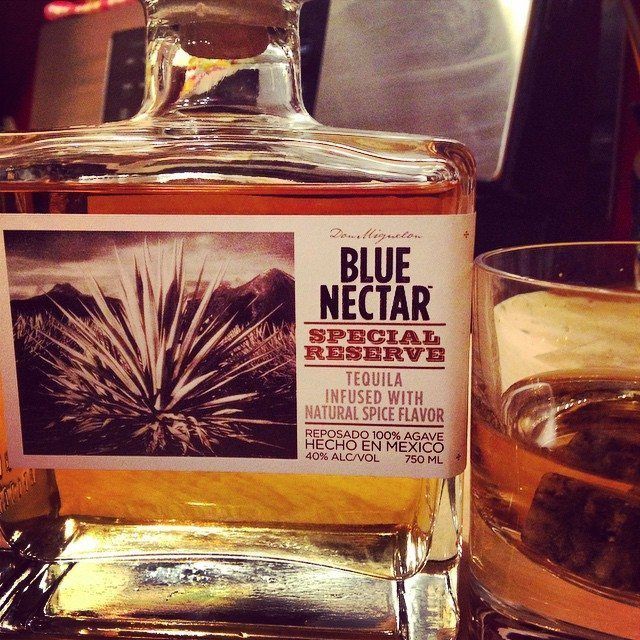
A bottle of reposado tequila. Image: Flickr / Emmanuelle Bourgue
AÑEJO (AGED)
Añejo tequila is tequila that has been barrel-aged for at least one year. As expected, it takes on a darker amber color, as well as more flavors from the barrels in which it's aged, often resulting in a smoother, richer, and more complex-tasting tequila.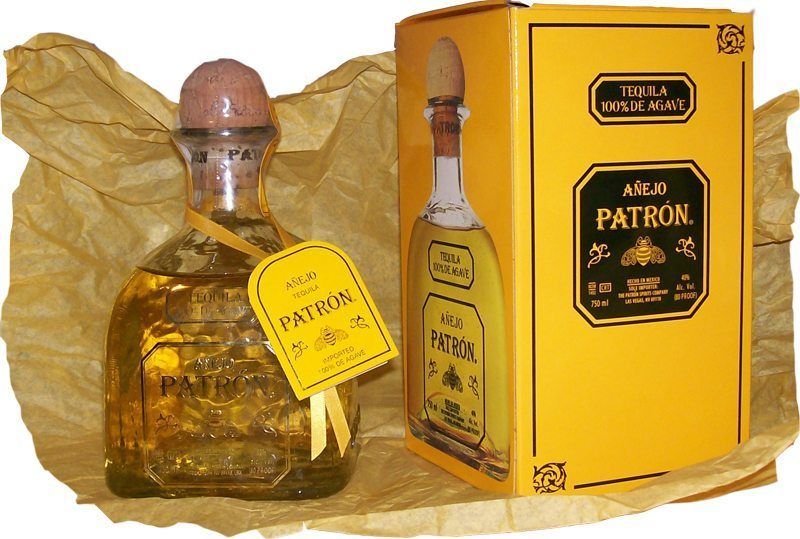
A bottle of añejo tequila. Image: Wikimedia / Broncinbuck
EXTRA AÑEJO (EXTRA AGED)
Finally we have Extra Añejo tequila, which is a relatively new classification of tequila added in 2006 by the Normas Oficiales Mexicanas. As Tequila.net notes, "With this extended amount of aging, the Tequila becomes much darker, more of a Mahogany color, and is so rich that it becomes difficult to distinguish it from other quality aged spirits." Often times after this extensive aging process, distilled water is also added to bring down the ABV of the tequila and add smoothness overall.
Bottles of extra añejo tequila. Image: Flickr / Bill Bumgarner
HIGHLANDS VS. LOWLANDS (OR "THE TEQUILA VALLEY)
Real tequila nerds who go deep on the blue agave spirit not only concern themselves with how long tequila has been aged (if it's been aged at all) as well as whether or not it's made from 100% blue agave, but also with whether it's come from the highlands or the lowlands. According to the Taste Tequila site, "Fans of the Highlands, also known as 'Los Altos,' claim that the soil is richer, and so agaves grown there are sweeter and produce tequila that is fruitier-tasting. Proponents of the Tequila Valley often point out that the region has a better water supply and agaves grown there produce an earthier flavor. But, given that different production methods can produce wildly different tequilas, we wondered how much the Highlands/Tequila Valley debate actually mattered." (Keep in mind that the lowlands, despite their name, aren't actually that low, as the city of Tequila is actually 3,870 feet above sea level.) Below is an awesome explainer video of the difference put together by Taste Tequila. https://www.youtube.com/embed/aYz9uEeUspY As an important note with the highlands versus lowlands debate, it seems that, again, according to Taste Tequila, it's kind of a draw — even among experts — in terms of which altitude of Jalisco territory produces better tequila. So if you hear lowlands or highlands, don't assume it's higher or lower quality right off the bat.NORMAS OFICIALES MEXICANAS (OFFICIAL MEXICAN STANDARD)
Now that you know the categories of tequila, the types of tequila, and where different tequilas originate, you'll need one more piece of information in order to fully understand any given tequila bottle history/label. And that piece of information has to do with the NOM identifier on the tequila bottle.
Picture of the NOM official logo. Image: Wikimedia / Tequila Regulatory Council
NOM, which is an acronym for Norma Oficial Mexicana (Official Mexican Standard), is a set of standards that businesses must obey in Mexico, and they actually apply to more than just tequila. But in the context of tequila, NOM standards are basically just certain criteria that a tequila must meet in order to be considered tequila. As noted by Tequila.net, "the NOM ensures the protection of the Appelation of Origin, regulates production, and continually establishes standards required to ensure quality. Those companies that comply with the regulations set forth by the Tequila NOM are then certified by the TRC (Tequila Regulatory Council), and labeled as an authentic Tequila producer." https://giphy.com/embed/O2YSazBbYlB84 As a little side note here, the TRC, or CRT (Consejo Regulador del Tequila), is actually a private organization that has been established to help make sure tequila producers are manufacturing their products in accordance with NOM standards. As The Tequila Specialist points out, "The CRT is a private non-profit organization with a worldwide scope that renders impartial decisions as to whether or not a product complies with the Standards." The Tequila Specialist adds that "the CRT is the only private organization accredited by the Federal Mexican Government to evaluate the conformity to the Official Standard of Tequila by performing verification and certification activities."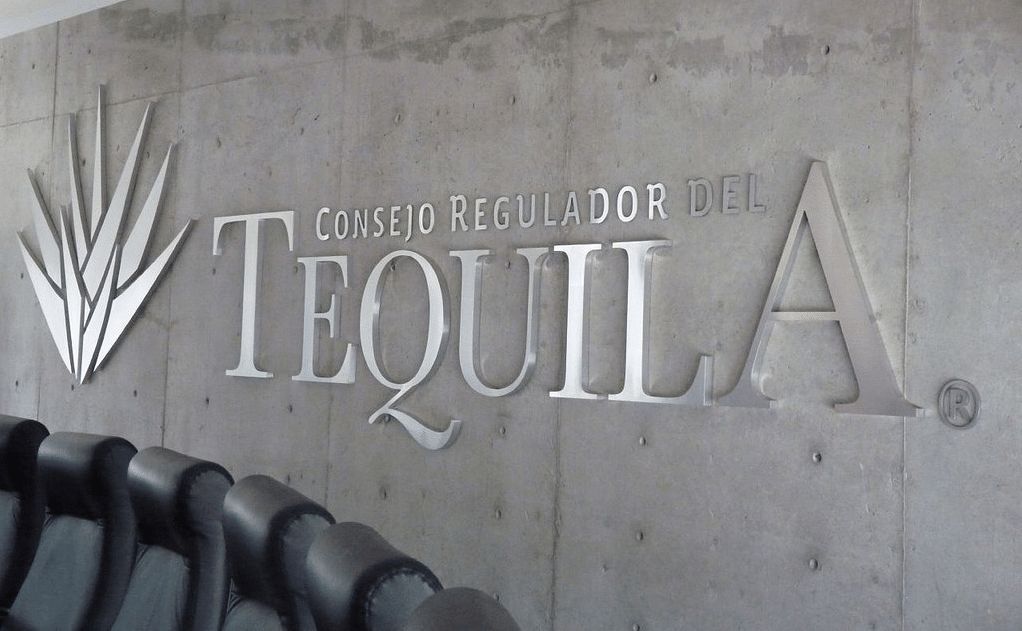
A glimpse of the Tequila Regulatory Council's offices. Image: Flickr / ychamyuen
In terms of what this actually means and how it's relevant to tequila labels, you'll want to look for a NOM number because that tells you that the tequila you're holding is an official tequila from Mexico, which has been produced at a given distillery. For example, you may see "NOM 1535" on a bottle of DeLeón tequila, which tells you that this bottle of tequila complies with NOM standards and was produced at the distillery associated with the number 1535. If you want to look up which distilleries are associated with various NOM numbers, you can do so with the Tequila.net NOM database. Keep in mind that the NOM number does not tell you where in Mexico the tequila was produced, only which distillery produced it. You could still just look up where a given distillery is in Mexico once you have its name though, right? Also keep in mind that a lot of distilleries produce more than one brand of tequila, so you may see different tequila brands with the same NOM numbers on their labels.HOW TO DRINK TEQUILA LIKE THE PROS
OK folks, now that we have all of the technical stuff out of the way, it's time to get to the fun part: How to drink tequila like a pro — keep in mind that if you can, always go with 100% blue agave tequila. Now here are some tequila drinking tips and options!DRINKING TEQUILA NEAT, NICE AND SLOW
Like whiskey, you can absolutely just sip on some tequila neat with no ice, no lime, no salt, none of those extra, flavor-affecting additions. BUT, you want to make sure you go with the right kind of tequila when it comes to sipping on it neat. https://giphy.com/embed/eL6S5UfChLEs0 Remember how we mentioned that different tequilas have different flavors? Well that information comes in extra handy when it comes to neat tequila. For example, blanco is generally not the best tequila to sip on because it hasn't been smoothed over and flavor-enhanced with barrel aging. So if you're just sipping on neat tequila — at room temperature or chilled, either is acceptable according to the snobs — aim for a reposado, añejo, or extra añejo that way you get some of that barrel flavor in there, which will give you many more nuanced flavors. Also, for drinking tequila neat, you'll definitely want to go with a 100% blue agave tequila rather than a mixto — it'll make a tremendous difference when it comes to flavor, and more importantly, it will help you avoid a hangover. And take your time while sipping too. Feel free to nose the tequila just as if it were a whiskey (it has been barrel aged, after all), and then sip it and let it rest on your tongue for a bit while you "chew" it. If it's proper 100% blue agave tequila that's been aged, you're going to unlock a lot of flavors that you otherwise wouldn't if it were in a mixed drink. As a side note, in some regions of Mexico it's also customary to follow up little sips of tequila with a drink called sangrita, which is a combination of orange juice, grenadine syrup, and hot chillies. (Not to be confused with Mountain Dew Sangrita Blast.)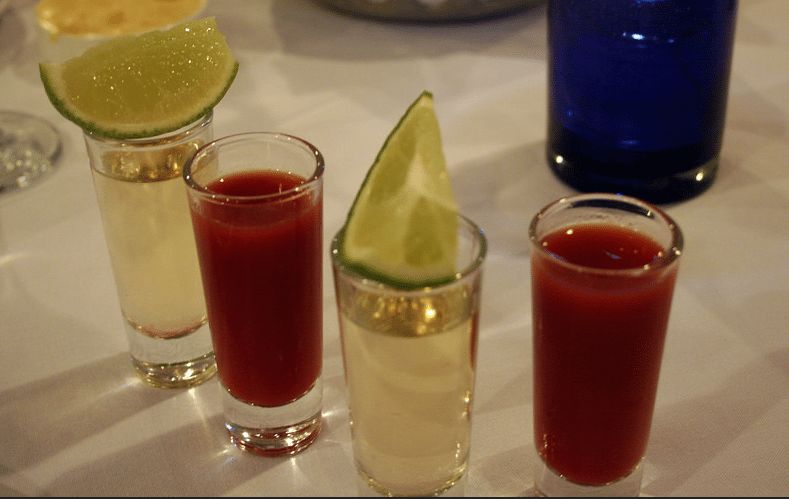
Sangrita next to tequila. Image: Flickr / Lucian Savluc
DRINKING TEQUILA AS A SHOT
OK, this is where we get into very familiar territory, right? Usually the sequence is: lick the wedge of skin between your thumb and pointer finger, drop some salt on that wet spot, grab a slice of lime, then lick the salt, take your shot of tequila, and suck on lime. Final, optional step: Scream like somebody just smacked your mama. The idea being that the saline taste up front will neutralize a mixto's harsh flavor, and the citrus from the lime juice will help to erase any gnarly aftertaste on the backend. https://giphy.com/embed/xLbXyrNcTEqWs But most tequila aficionados would never use lime or salt to drink their tequila, even if they were doing shots. Why the ritual in the first place then? According to Cecil Adams of The Straight Dope (a popular Q&A column that's been around since 1973), this practice actually did originate in Mexico. Here's what he says about why the tequila-lime-salt combo came to pass:"Mexicans have long known that a little sodium chloride on the tongue can help to mollify the fiery flavor that characterizes much of their food. They use salt when downing chile peppers, for example. By the same token, citrus juices of various kinds have long been used to kill the aftertaste of the more potent forms of alcohol. For example, poor black folks in the U.S. used to cut their port wine with lemon juice. The Gallo wine company noticed this and began marketing Thunderbird, a white port-citric acid mixture. Anyway, when tequila came to the U.S., the salt and lime (or lemon) bit came with it."In terms of why connoisseurs don't like the practice, it seems that the thinking goes: 100% blue agave tequila (the only kind aficionados would drink) shouldn't be tainted with lime and salt. And as far as mixtos? That shit can't even grace their tongues, so why bother trying to improve the taste with lime and salt? If you do want to do your shots with lime and salt however, take comfort in the fact that it is a genuine tradition that originated in Mexico. Also, fuck people who try to tell you how to drink your drink, right? https://giphy.com/embed/p9brh0BxLzBTy
DRINKING TEQUILA IN MIXED DRINKS
When it comes to adding tequila to mixed drinks, the good news is, if you're adding low-quality mixto tequila, the drink will mask its flavor; the bad news, if you're adding quality 100% blue agave tequila, the mixed drink will mask its flavor. But there's a more important question, right? Do connoisseurs approve of putting tequila in mixed drinks at all? https://giphy.com/embed/YYIeKT80xZNzq There doesn't seem to be any real consensus among seasoned tequila drinkers as to whether or not tequila belongs in a mixed drink. Some say that it should really only be enjoyed on its own, while others have no problem with either mixto or 100% blue agave being thrown into a mixed drink. If you do decide you you're down with making tequila-based mixed drinks — and we're betting you will — below are five traditional tequila cocktails with recipes for you to try out.HOW TO STORE TEQUILA
Here's the really good news about storing tequila: All you need to do to make sure its quality is kept intact is store it in a cool, dark place at room temperature, while also making sure that it's securely sealed. Simple enough, right? In terms of specifics, all the rules are pretty common sense. Don't store bottles of open tequila (as some of their alcohol will evaporate), don't store tequila someplace warm, and don't store it in a freezer. Yes, we're looking at you (21-and-over) college students who keep your Jose Cuervo in your little dorm room fridge.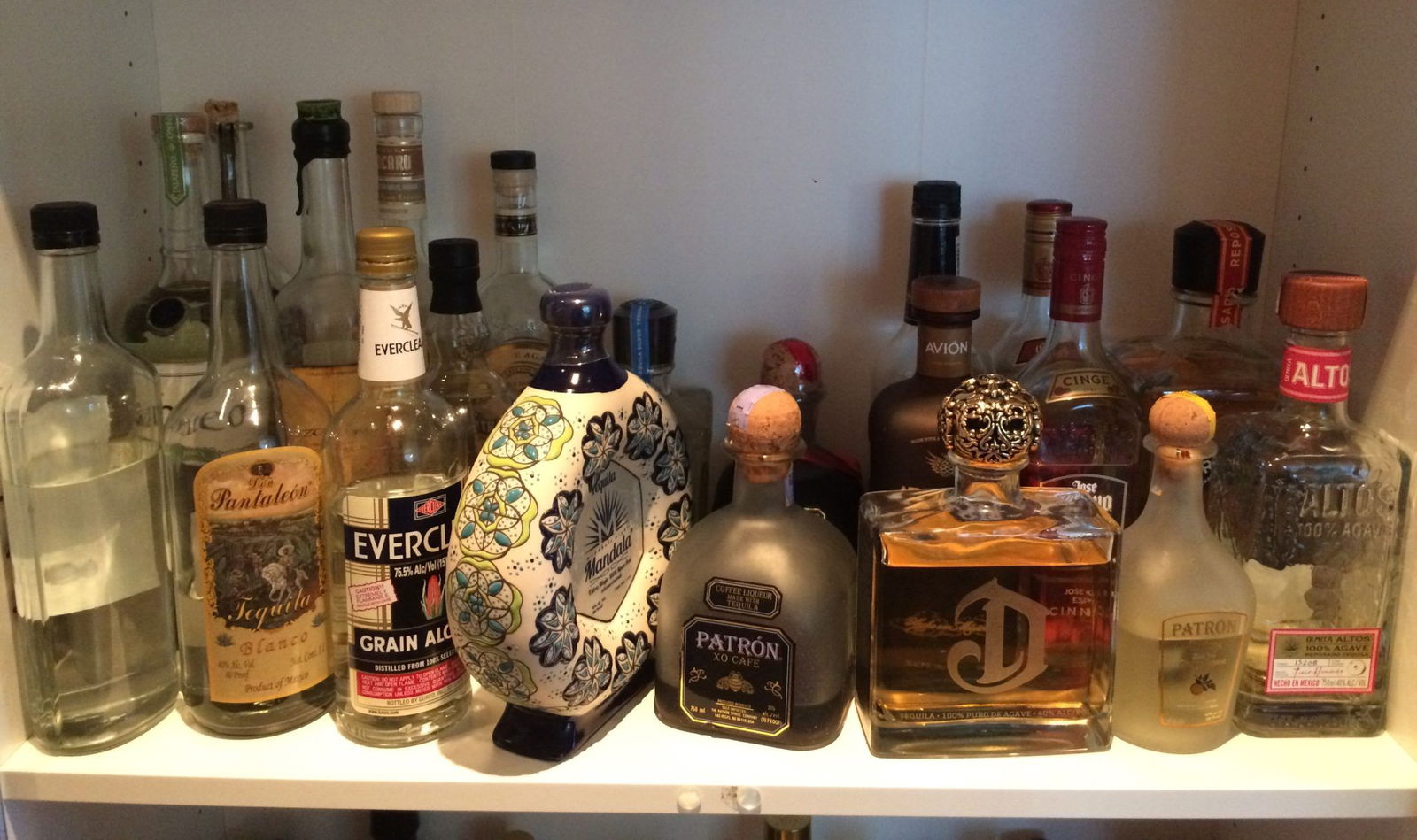
The way we keep our tequilas stored at Tipsy HQ — can you spell B.A.S.I.C.? Seriously though, this is how it's done. Image: Tipsy Bartender
Also, keep in mind that after you open a bottle of tequila, it's going to oxidize just like a bottle of wine. And while you don't have to worry about tequila the way you would about a bottle of wine, you'll still want to make sure your bottle is kept shut tight after it's open, otherwise it'll start losing its flavor, usually within a month. And if you want to get real quirky with your tequila storage, you can keep it in little wooden barrels like this one. Although tequila in these tiny wooden casks may take on an extremely woody taste that could mask the tequila's natural flavor profile.WTF IS UP WITH THE WORM?
OK, now we have to talk about... THE WORM! A.k.a. gusano de maguey. And what do we have to say about that? Eff the worm! Seriously though, a bottle of tequila should never, ever have a worm in it. According to VinePair, "the worm in the bottom of the tequila bottle is an old school myth, a misunderstanding born of some marketing savvy and probably bolstered by the rowdy one-upsmanship of tequila swilling machismo." But even though the worm is not actually associated with tequila, it is associated with mezcal. So you may see some genuine bottles of mezcal with a gusano de maguey in them. But even though you may rightly find a worm in your mezcal, as far as why it's actually in there in the first place is still kind of unclear.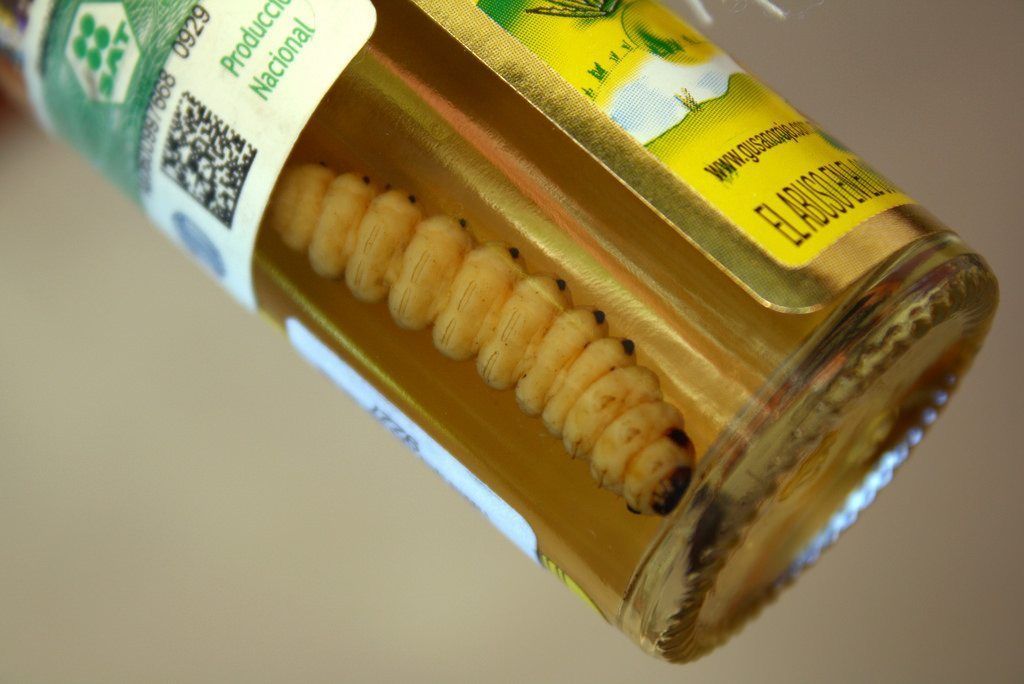
The worm in a bottle of mezcal. Image: Flickr / Rodrigo Tejeda
For example, Delish notes that one theory traces the origin of the mezcal worm "back to a distiller named Jacobo Lozano Páez, who in 1940 found that the larvae changed the taste of the agave and so began adding it to his spirits." Delish also notes that others attribute the mezcal worm to a test of potency — if the mezcal can pickle the worm, it must have a high percentage of alcohol, and therefore be good booze. VinePair adds that "There’s also the possibility this was purely a marketing angle, aimed at the American market. Tequila was flooding the U.S., and mezcal needed a way to differentiate itself. From here, ideas that the gusano indicated purity (a strong, pure mezcal would keep the worm intact) or could impart virility or good fortune were just a matter of some marketing imagination." Bottom line here: If you're talking about tequila, forget about the worm. If you're talking about mezcal, it may come in some bottles, but it's definitely just a marketing ploy.THE FUTURE OF TEQUILA
In terms of what's in store for tequila in the future, it seems that things are mostly bright, especially concerning premium and ultra-premium tequilas (think Casamigos, Patrón, Avion, etc.). The boom in tequila demand — again, mostly at the higher end, especially in the U.S. — isn't all good however, as it's apparently leading to a blue agave shortage. But despite the shortage, there are new technologies entering the tequila game, which will, at the very least, help growers keep an eye on their plants.BRIGHT FUTURE FOR PREMIUM AND ULTRA-PREMIUM TEQUILA
Like whiskey, it seems that the market for tequila is definitely on the upward trajectory. According to a Business Wire release put out by the market research company, Technavio, the global tequila market is expected to be worth around $9 billion by 2019 with "The increasing demand for premium tequila among consumers [being] one of the major drivers of the market." Technavio also notes that flavored tequilas are going to help grow the industry, especially because the female consumer base is driving much of the growth, and it seems women prefer "prestigious and flavored drinks." Manjunath Reddy of Technavio notes that “An increase in endorsements by celebrities, development of innovative packaging techniques, and growing online retail is expected to propel the growth of the market in Europe [through 2021]." No wonder everybody from Elon Musk to The Rock is getting into tequila. https://giphy.com/embed/3s4lT38H7yM4ZBbSm0 In terms of which corporations are expected to benefit most from the growth, Technavio says that Beam Suntory, Brown-Forman, JOSE CUERVO, and Patrón Spirits International will be the big winners.THE POSSIBILITY OF A BLUE AGAVE SHORTAGE
Here's the downside to tequila's growing popularity — the possibility of a blue agave shortage. According to a 2018 Reuters report, "The price of Agave tequilana... has risen six-fold in the past two years, squeezing smaller distillers’ margins and leading to concerns that shortages could hit even the larger players." And unfortunately, this rise in price has happened concurrently with the aforementioned rise in demand. But what will this actually mean for tequila producers and consumers moving forward? Even more reason to sell and buy premium tequila! With premium tequilas, the rising price of blue agave plants doesn't affect the bottom line as much as it would lower priced tequilas because the margins aren't as slim. So you have a compounding reason for premium and super-premium tequilas to flourish. One: the market wants it more, and two: the margins are way better for producers. This blue agave shortage isn't just hyperbole either. According to the same Reuters report, "the 17.7 million blue agaves planted in 2011 in Mexico for use this year [2018] fall far short of the 42 million the industry needs to supply 140 registered companies, according to figures from the Tequila Regulatory Council (CRT) and the National Tequila Industry Chamber (CNIT)." That's a difference of 24.3 million blue agave plants needed to meet demand. https://giphy.com/embed/krZldGvs7kRWg But don't fret, because producers are working on ways to combat the shortages, and it seems that new growing strategies may be able to remedy the problem by 2021. (Although we should emphasize the may part, as it seems there's still skepticism in the industry as to whether or not these growing strategies will be able to make up for all the blue agave that's needed.)DRONES FOR MONITORING BLUE AGAVE FARMS, VR FOR MARKETING EXPERIENCES
Like just about every other industry on the planet, the tequila industry will also be disrupted by drones, and to some extent, virtual reality. The drones are coming into play to help growers keep an eye on their crops (and may help with the shortage issues), while the VR is going to aid tequila marketing by allowing people to experience the tequila industry behind the scenes like never before. When it comes to using drones, Ismael Vicente, the head of the Tequila Regulatory Council's agriculture division told Food&Wine that “We’re using [drones] to map exactly the 125,000 hectares that form the whole region of origin for tequila—that’s 25,000 agave plantations,” and that “We’re trying to get agricultural precision, a very clear snapshot of where we are in terms of agave supply.” Vicente added that “When it looks like you have an issue in an area, you send in a drone to give more precise details,” and “After seeing the images, a group of experts can go to that field and see what the exact situation is.” https://giphy.com/embed/fxw5aItPMfRGdx3qIP This means that tequila producers will have a much better idea of exactly how much blue agave they're producing, as well as the ability to tackle issues with growth in real time. The drones will also help producers make sure that growers are only getting their blue agave from designated tequila-production areas, and not sneaking in any extra plants from other regions — recall how important it is for the blue agave to come from the Jalisco region and a few of its surrounding municipalities. On top of that, the drones can help growers make sure none of their plants are stolen. In regards to VR, you're basically looking at the tequila industry using the new technology to help give consumers a glimpse into tequila production like never before. Below, for example, is a 2D video of Patrón's Oculus VR experience, which uses "virtual reality technology to bring you inside Hacienda Patrón, where that spirit lives and breathes daily." https://www.youtube.com/embed/cr3V4xt2710OUR FAVORITE TEQUILA DRINKS
OK, folks! Now that all of your tequila knowledge is in order — including how tequila is made, the history of tequila, how to drink tequila, the different types and categories of tequila, and the future of tequila — it's time to actually get to drinking. So take a look at the tequila cocktails below, make some of these delicious recipes with your friends, and most importantly, have fun! 1. THE CLASSIC MARGARITA 2. SLUSHY TEQUILA SUNRISE
2. SLUSHY TEQUILA SUNRISE
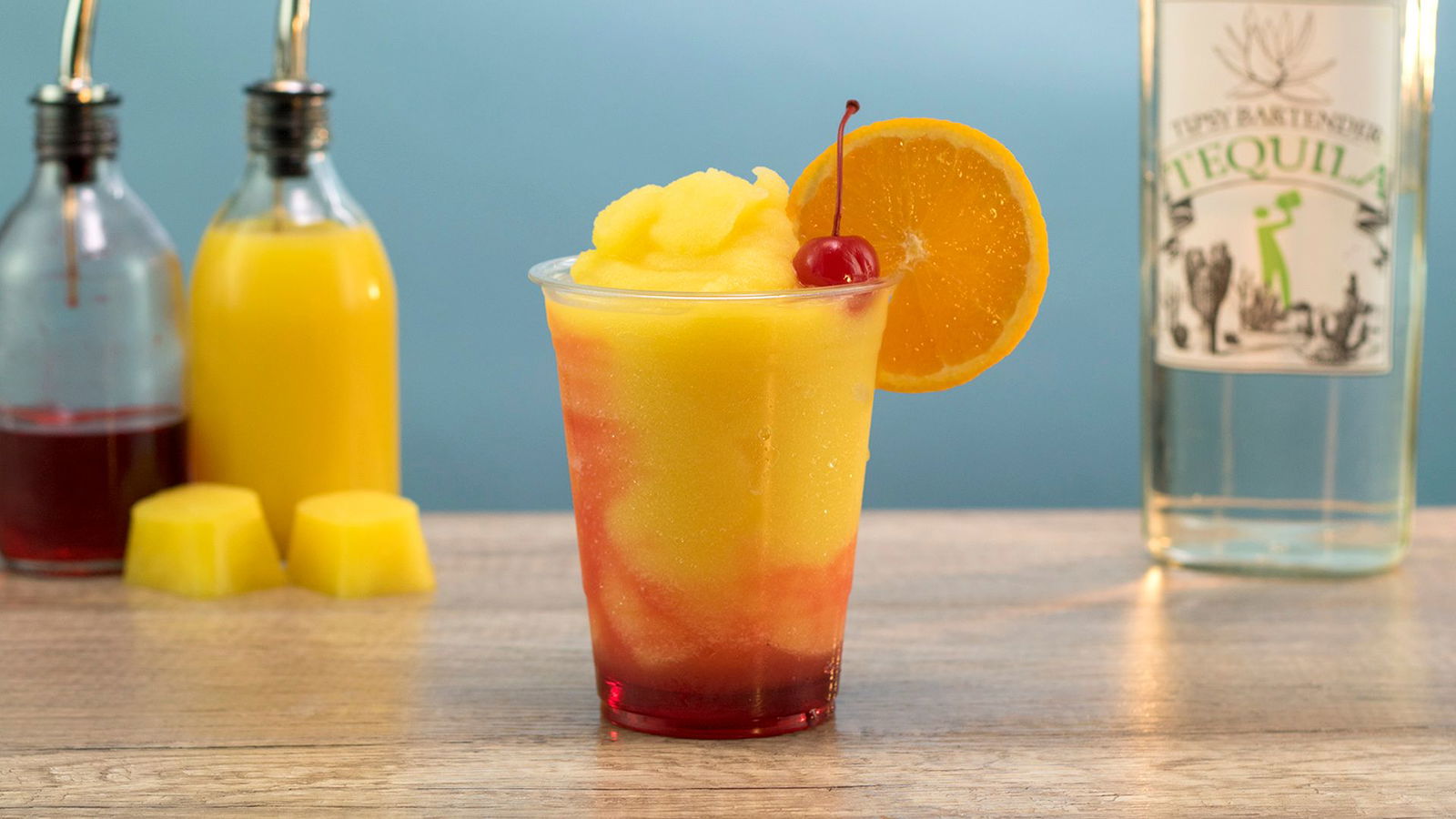 3. TEQUILA SUNRISE JELLO SHOTS
3. TEQUILA SUNRISE JELLO SHOTS
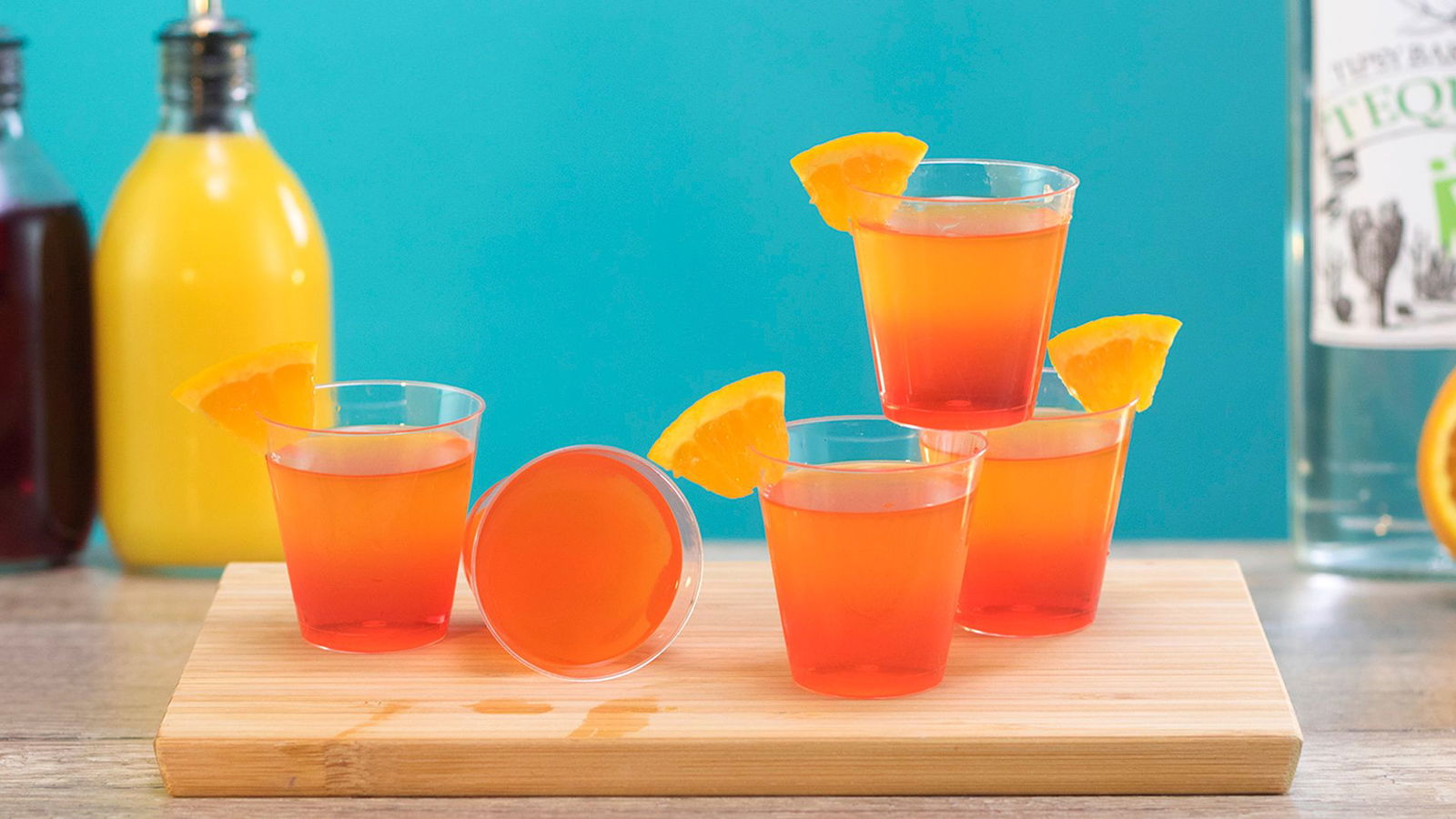 4. WATERMELON JOLLY RANCHER MARGARITA
4. WATERMELON JOLLY RANCHER MARGARITA
 5. MARGARITA POPSICLES
5. MARGARITA POPSICLES
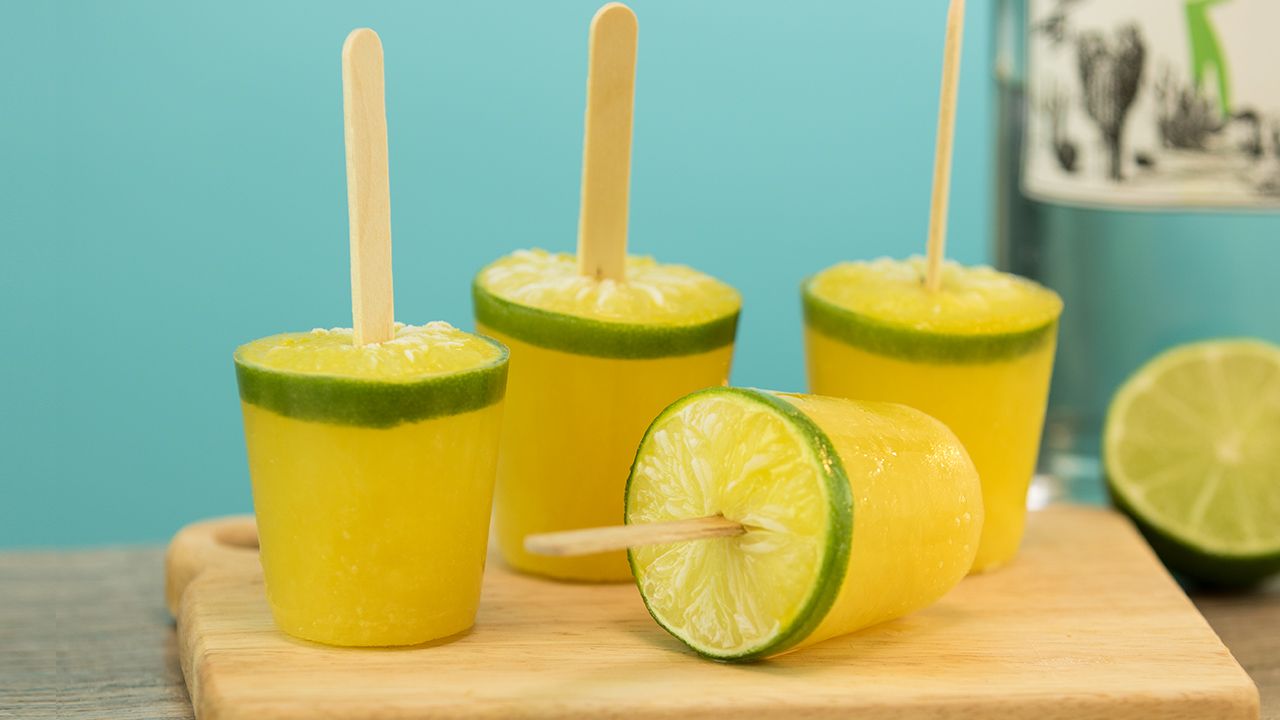 6. ROSA SANGRIA
6. ROSA SANGRIA
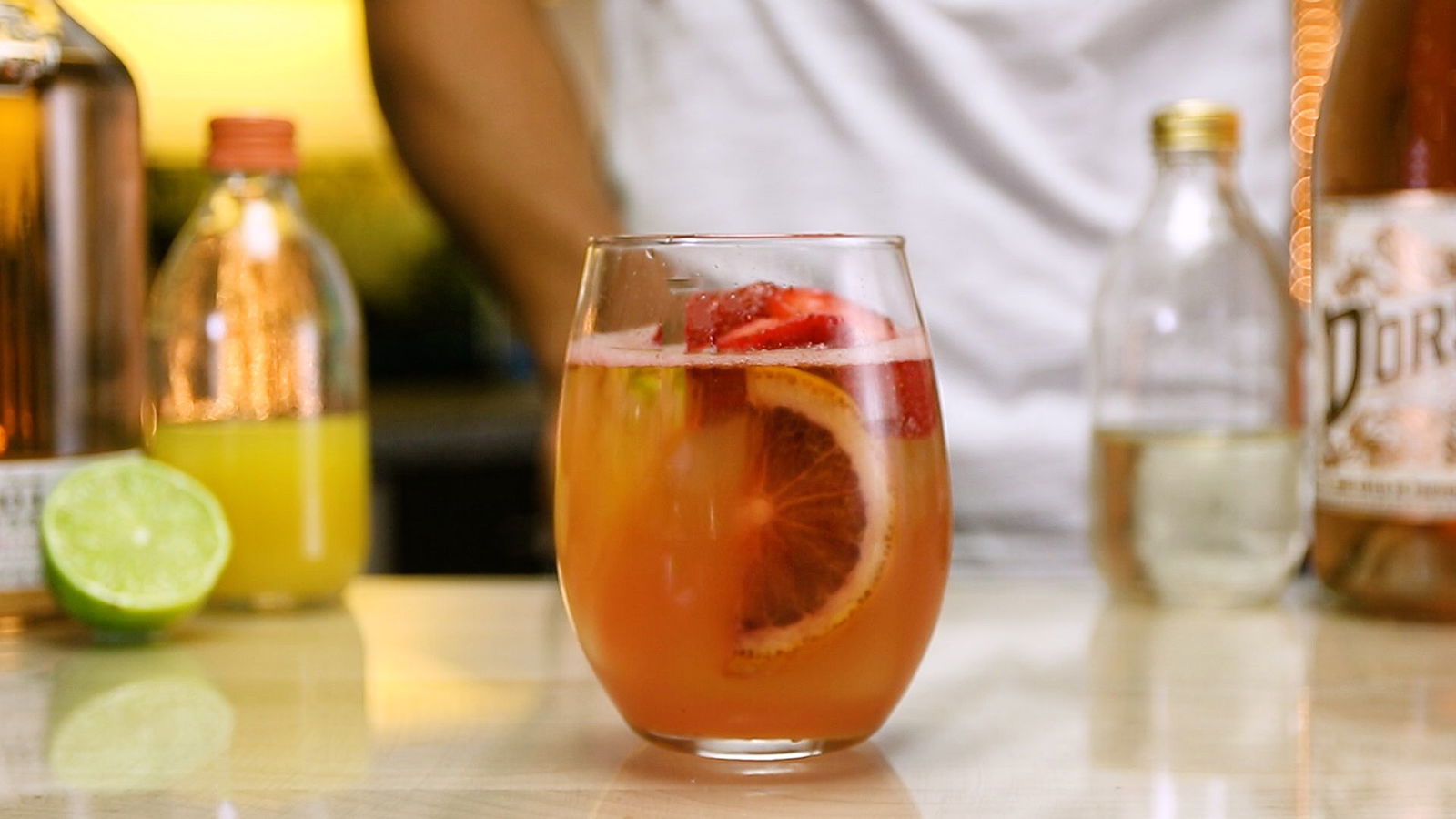 7. TEQUILA SUNRISE MIMOSA
7. TEQUILA SUNRISE MIMOSA
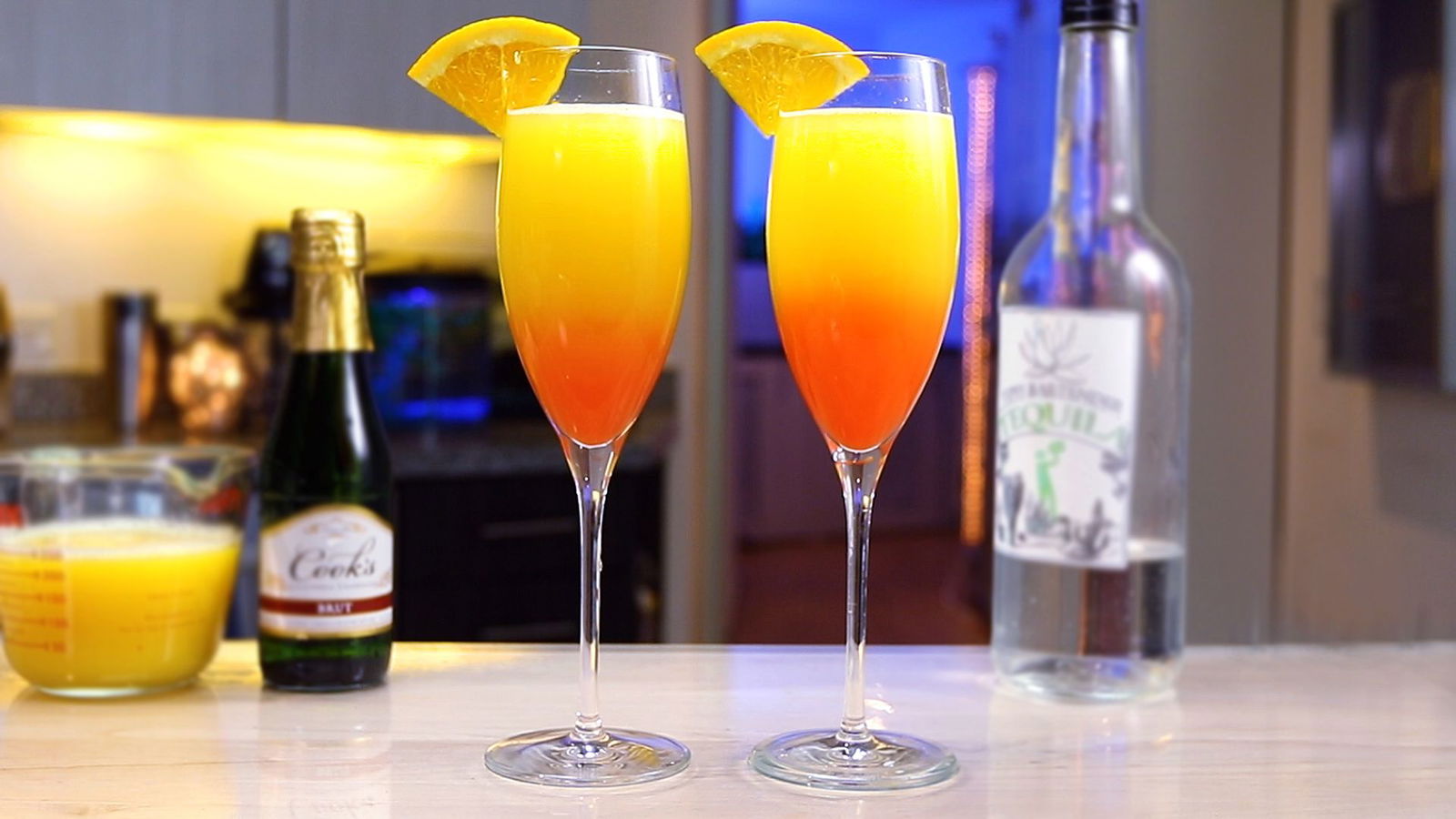 8. SAKE TO ME MARGARITA
8. SAKE TO ME MARGARITA
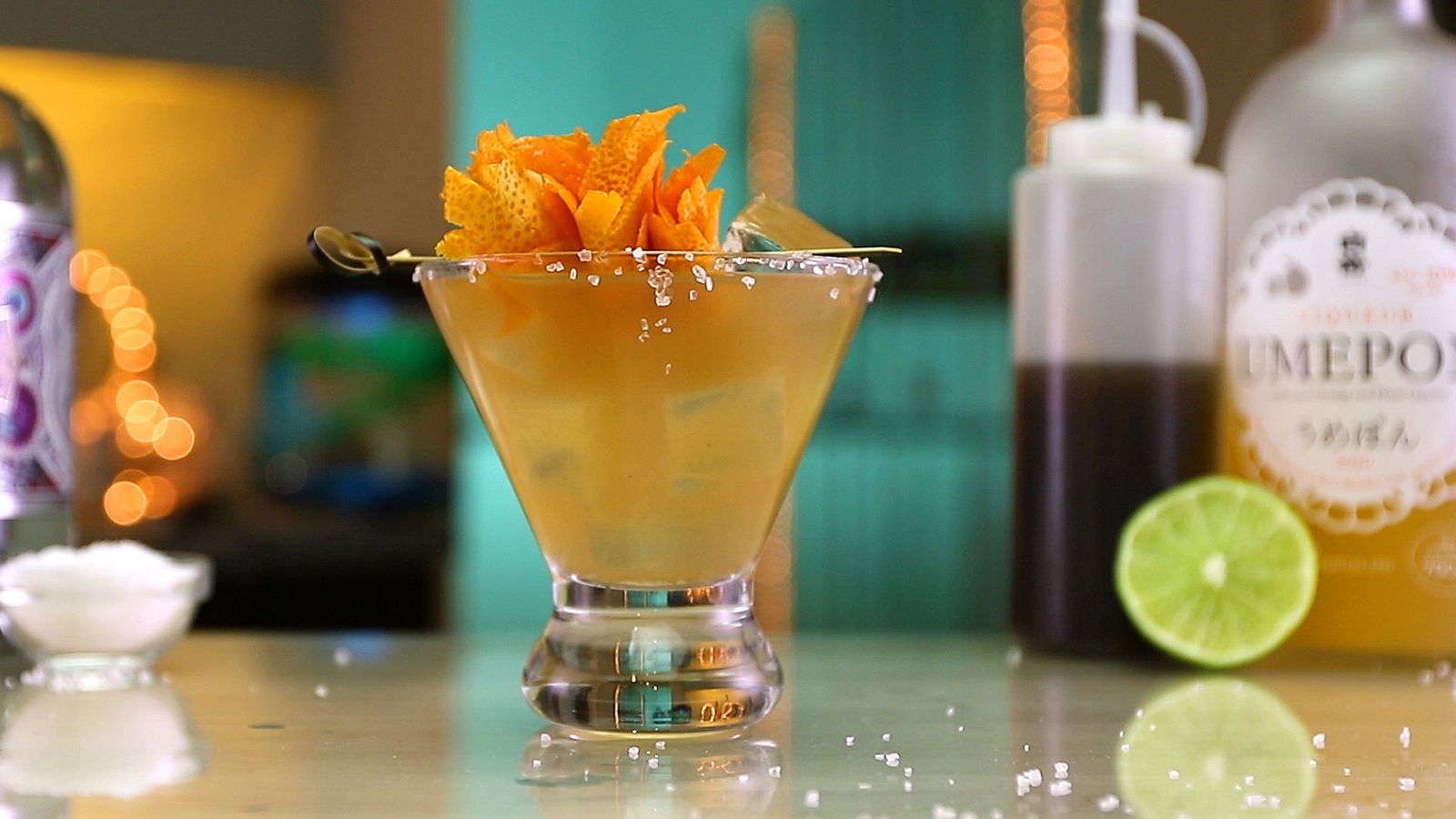 9. TROPICAL FISHBOWL MARGARITA
9. TROPICAL FISHBOWL MARGARITA
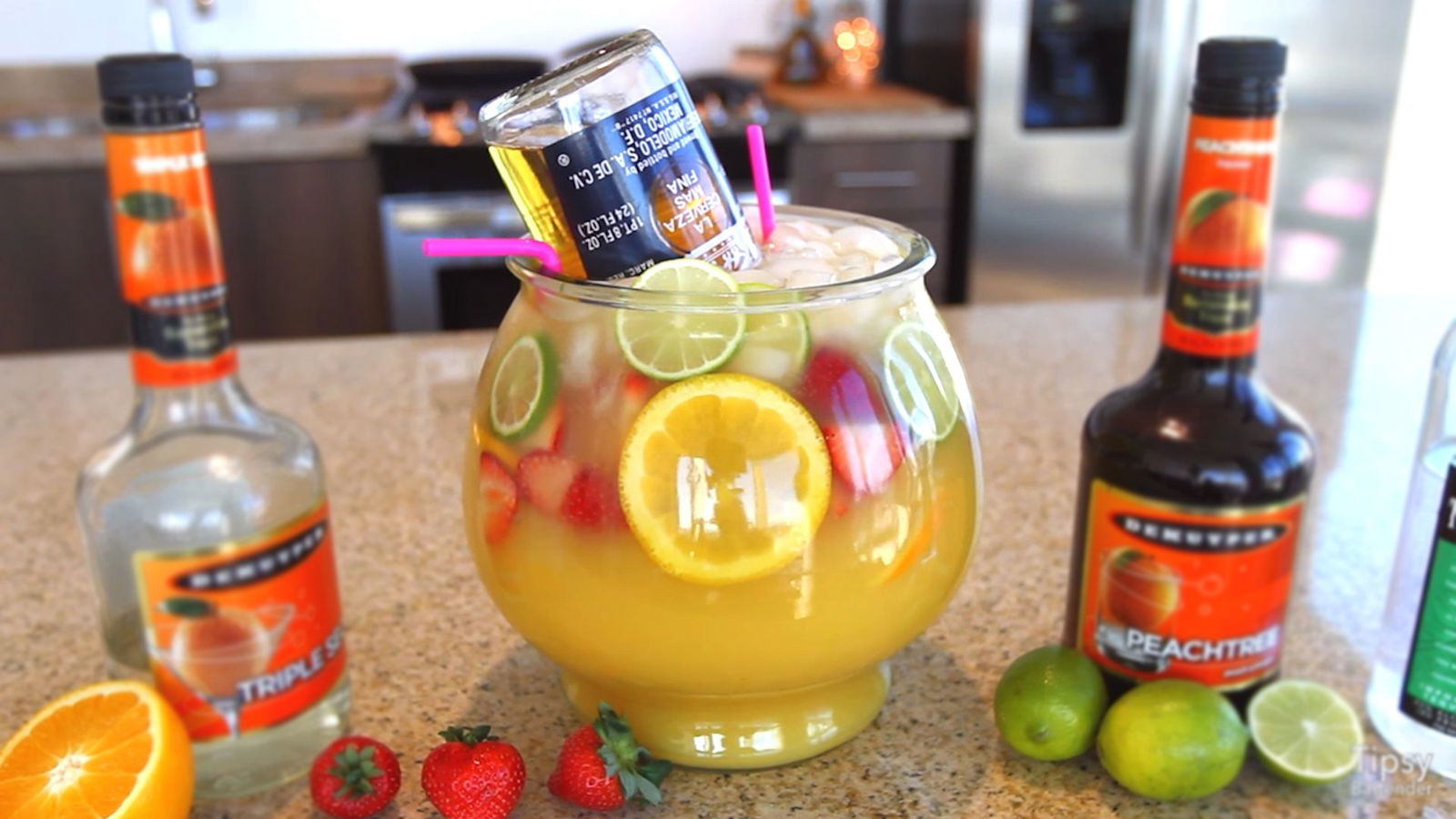 10. APPLE CIDER MARGARITA
10. APPLE CIDER MARGARITA

GIFS: Giphy

Independence Day Drinks
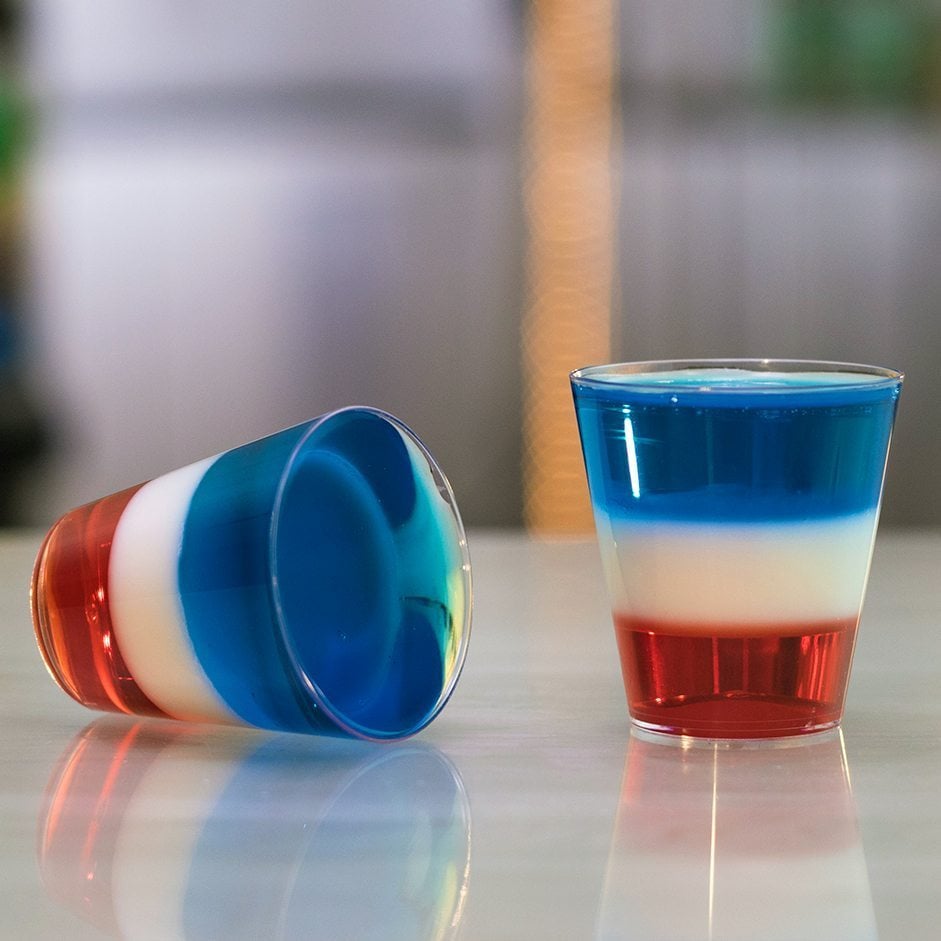
4th Of July All American Jello Shots

4th Of July Cake Vodka Milkshake

4th Of July Diversity Bomb Shot
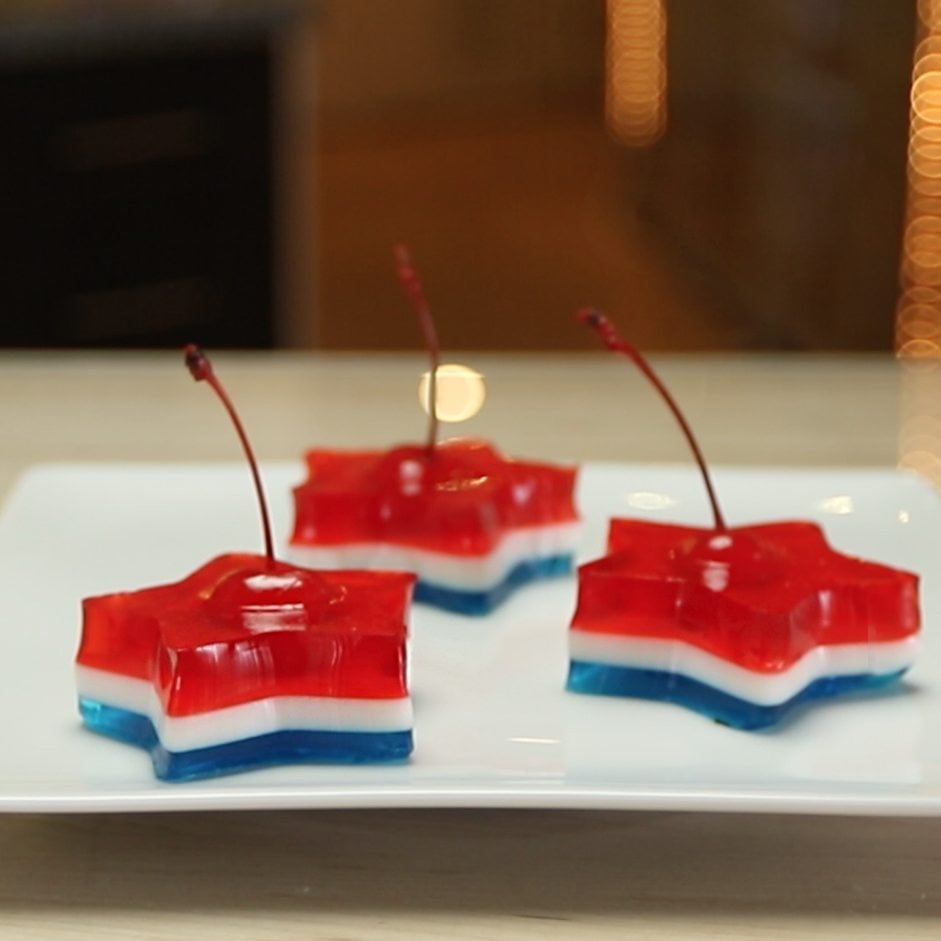
4th Of July Jello Shots
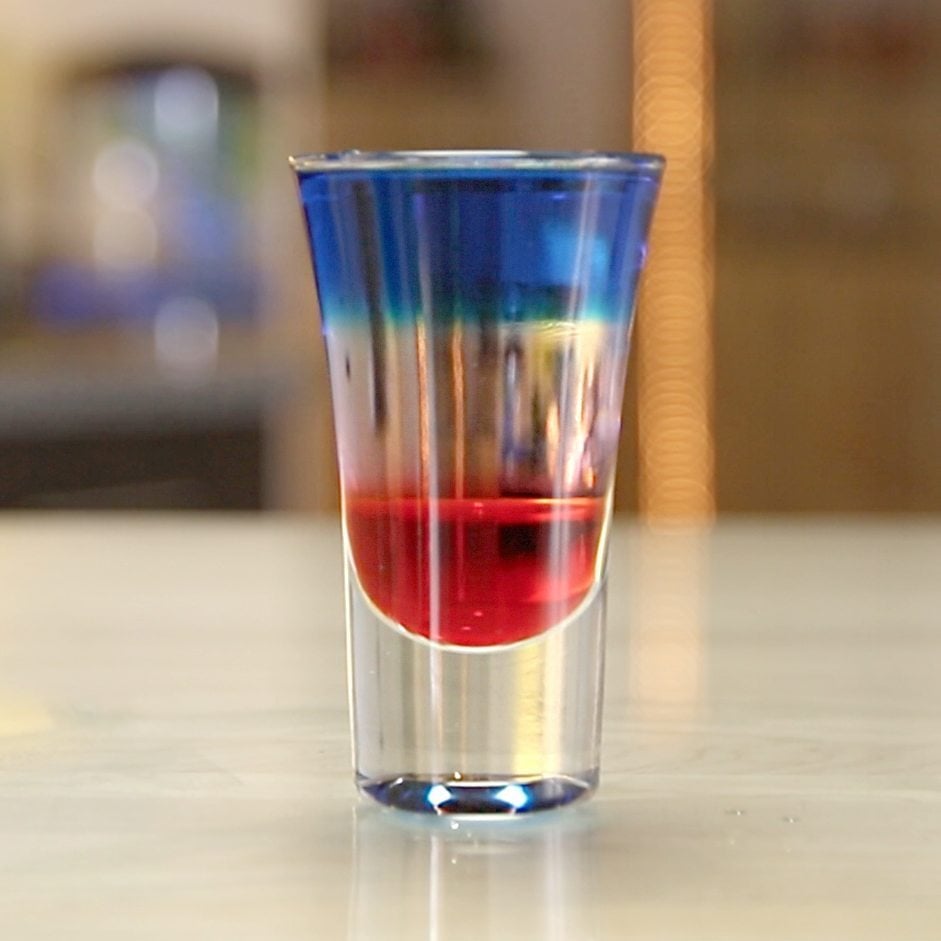
4th Of July Layered Shots
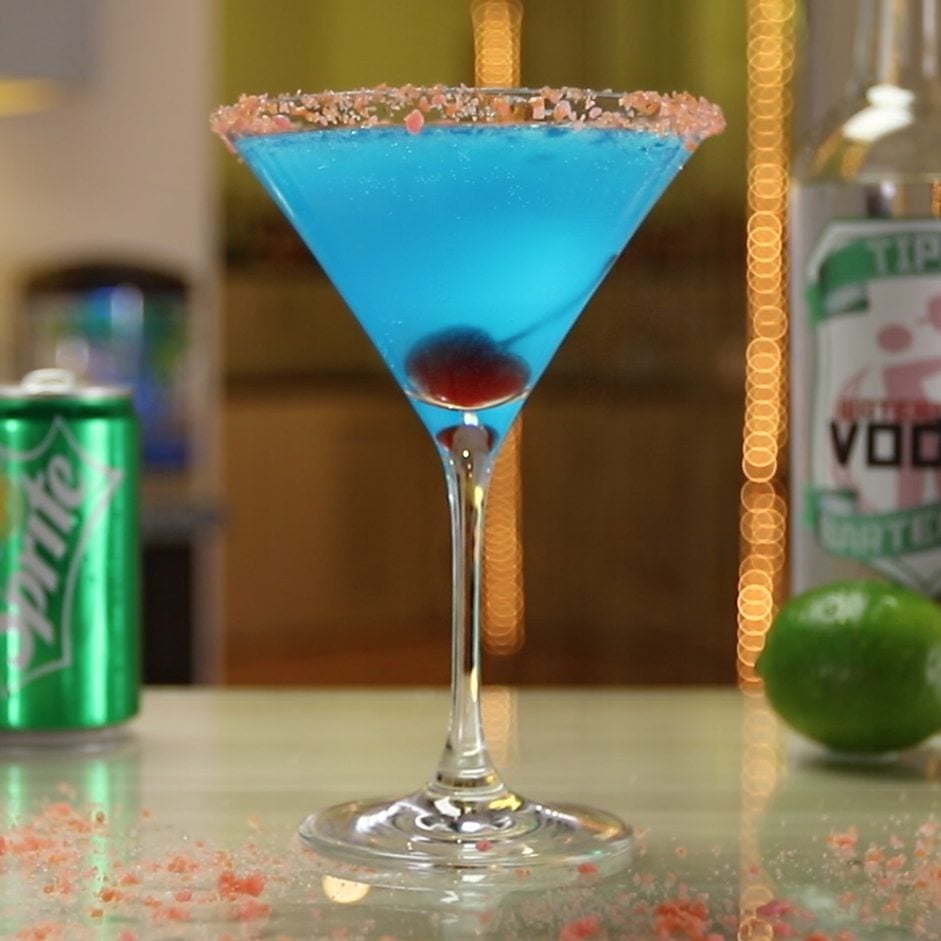
4th Of July Pop Rocks Martini
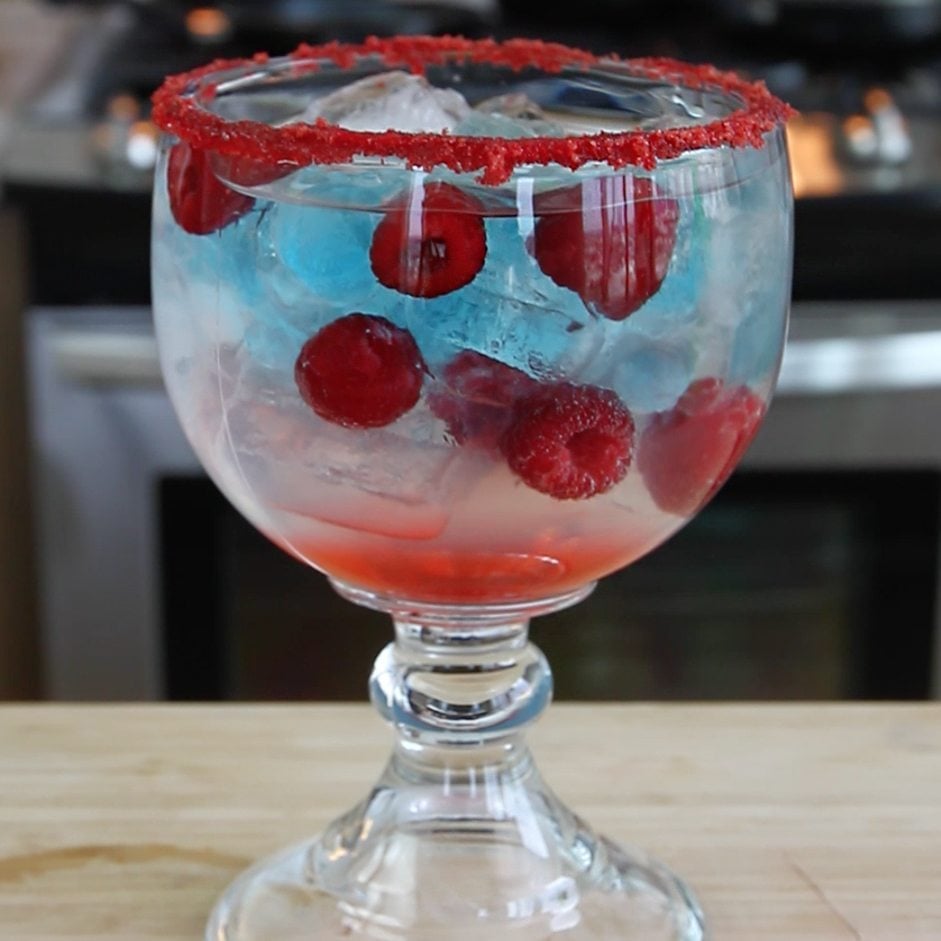
4th Of July Raspberry America

4th Of July Spiked Bomb Pops

4th July Popsicle Margarita
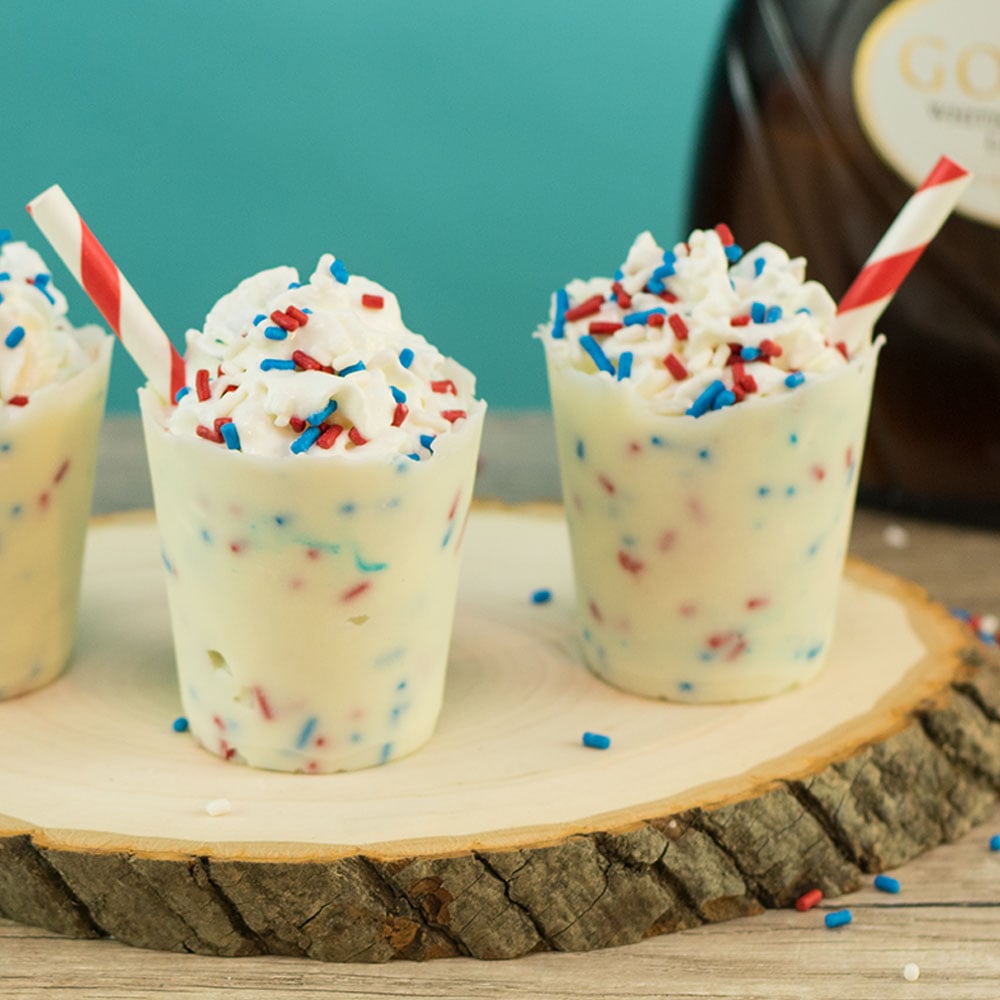
4th July Edible Shot Glasses
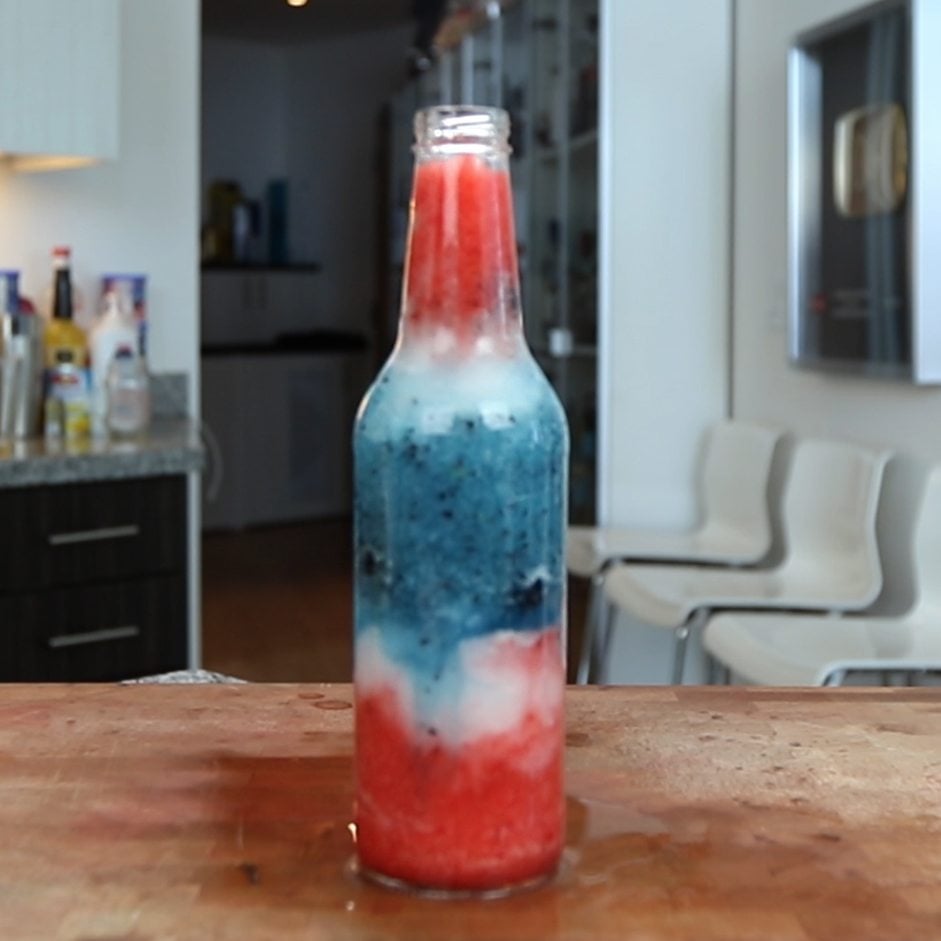
4th July In A Bottle
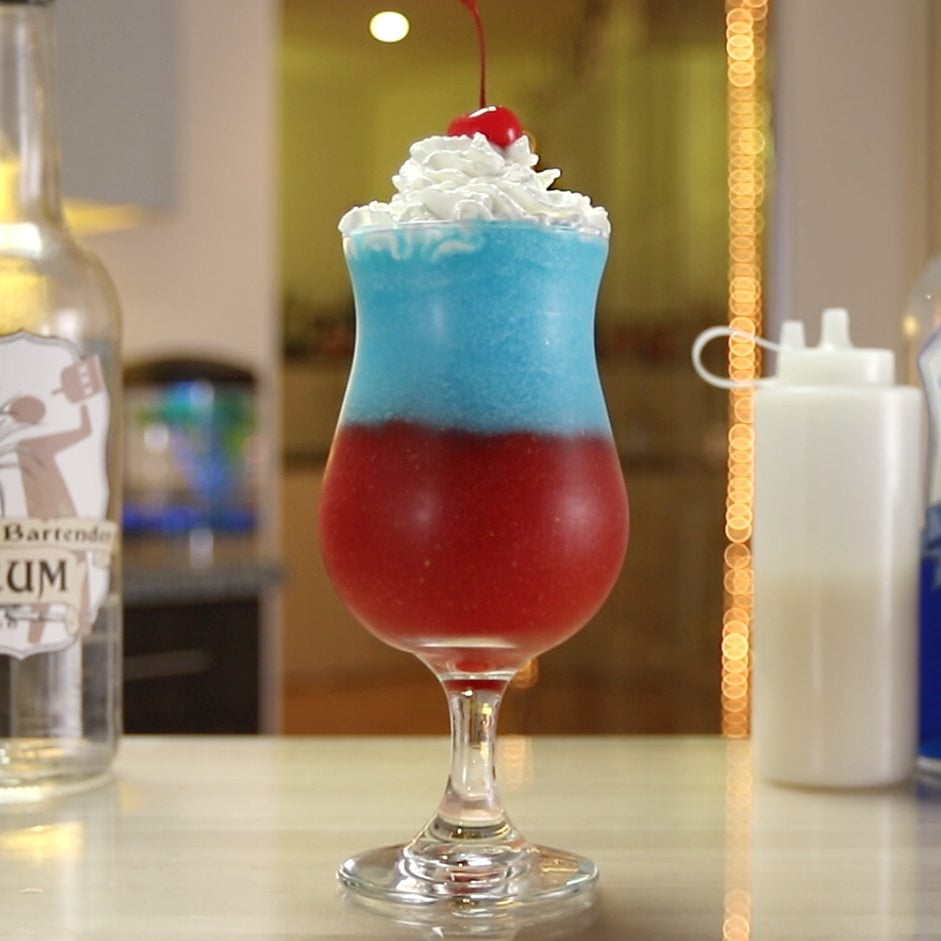
All American Daiquiri


